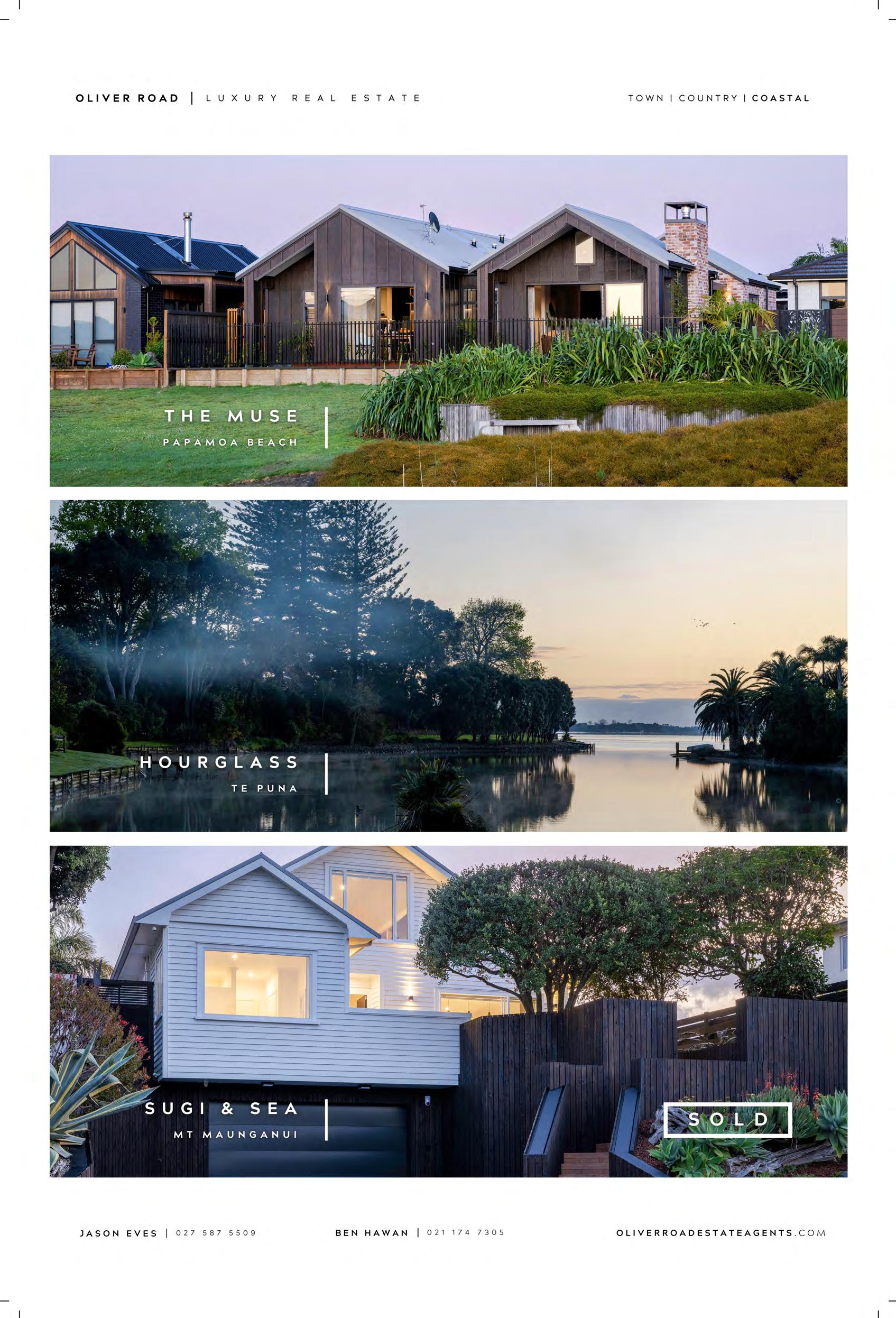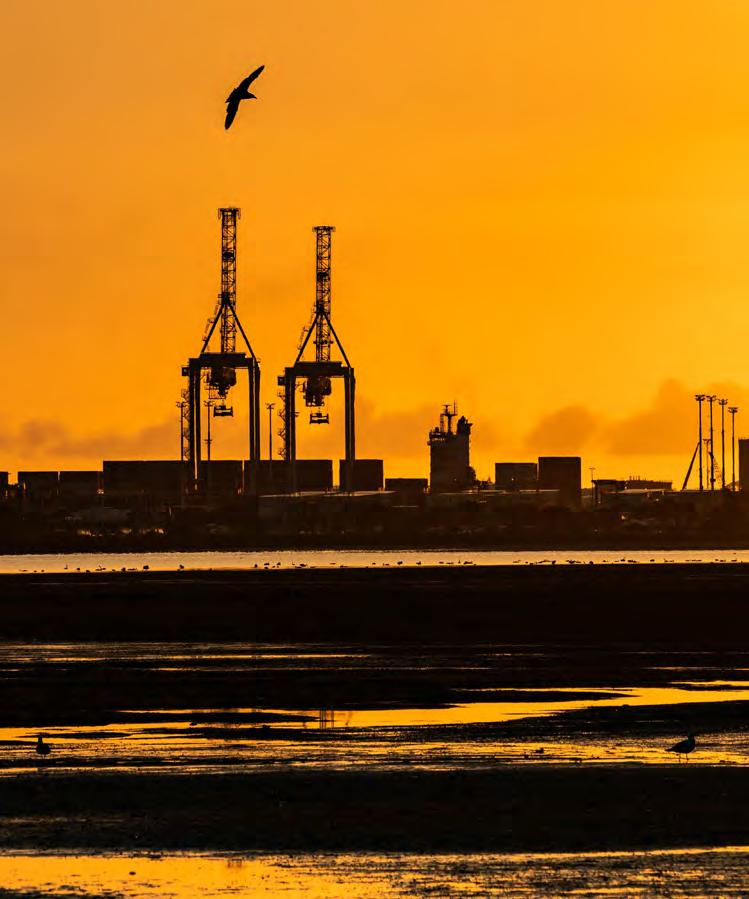

PORT BATTLING SHIP SCHEDULING
Challenging labour conditions, capacity issues at Ports of Auckland, and Covid have all played into continuing scheduling issues at Port of Tauranga, with expectations delays will not be fully sorted until early next year. See story page 3.

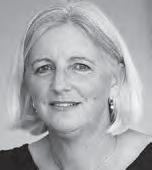
UTF explores construction supply issues
Tauranga’s Urban Task Force (UTF) hosted a panel discussion focused on supply chain issues at the end of August. Employers’ immigration scheme holdups in particular were highlighted, with some degree of frustration, as a major cause for concern, not only for those in the industry, but for the economy as a whole.
By ALAN NEBEN
The UTF was established in 2021 to provide leadership to local and central government, and local business, economic and iwi sectors. According to the group, UTF advocates for positive planning and investment decisions to create meaningful changes to the current state of Tauranga City.
The presentation, introduced by UTF’s Morgan Jones, outlined the current state of the industry from the individual perspectives of each of the four panelists.
Providing context, Priority One’s Nigel Tutt highlighted the July quarter record low unemployment rate of 2.9% for the Western Bay of
Plenty. He noted that construction, property and healthcare are the largest employment sectors in the region. He also pointed to the impacts of the current 7-8% inflation rate and labour shortages, particularly slow immigrant labour flows, as major impediments to growth. He noted competition for staff will be a significant feature of the local labour market.
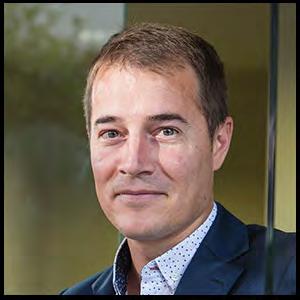
Tomkins Wake’s immigration expert Michelle Urquhart touched on the impact of Covid border closures and outlined the new work visa scheme, originally announced in 2019 for launch in 2020, but then delayed by border closures until the scheme finally went live in July 2022. She pointed out that, despite the quick uptake and processing of employer accreditations in May, a requirement for any employer now wishing to employ a migrant, the subsequent job check stage has been problematic.


Morgan Jones
First on the scene


Port battling ship scheduling
Challenging labour conditions, capacity issues at Ports of Auckland, and Covid have all played into continuing scheduling issues at Port of Tauranga, with expectations delays will not be fully sorted until early next year.
By RICHARD RENNIE
Data on global shipping to July indicates an uplift in shipping reliability after months of poor performance, with reliability levels now at 41% compared to barely 30% a year ago. This still compares poorly against pre-Covid global figures of 75-80%.
But logistics and freight company Kotahi’s latest shipping summary has Port of Tauranga, along with all other major ports in New Zealand recording a slide in shipping reliability. It reports all ports recording severe congestion, driven by weather events, vessel ‘bunching’ and lower levels of labour due to Covid infections across the country.
Overall, the effect has been to push New Zealand ports backwards in their scheduling reliability compared to the rest of the world. Tauranga fell from a relatively consistent 50% schedule reliability for much of the year, to below 40% for July.
Auckland, Napier and Lyttelton all recorded rates lower still, with Nelson the only exception for increased reliability in July.
Port of Tauranga chair Julia Hoare noted the issues the port continues to focus on when announcing its annual results in early August. She pointed to 65% of ships still arriving off-schedule and continuing delays in other parts of the New Zealand supply chain.



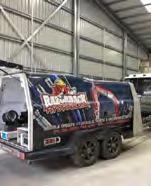
“Supply chain disruption continues to have a massive impact on our ability to deliver an efficient service for importers and exporters. We have done our best to incentivise smooth cargo flows and the financial results reflect that,” she said.
Vessel delays at Tauranga have increased to up to five days, and a port spokesperson said of the 16 vessels arriving at Tauranga each week on average only six are on time, and these are the ones calling direct to Tauranga.
“Ports of Auckland has said it expects to get back on schedule from March 2023, so we are hopeful we will return to better schedule reliability in the second half of the financial year,” she said.
The Port of Tauranga reported an increase in group net profit by 8.7% to $111.3 million while paying a total dividend of 14.7c a share, up from 13.5c the year before.
CEO of Kotahi David Ross said Auckland’s efforts to lift its operational capacity were a key to the entire country’s improvement in shipping scheduling.
“And Auckland is signalling their intention to be there by March, and everyone should be 100% behind that intent as it is good for NZ’s entire operations.”
The problems with port reliability have been heightened by issues around Maersk’s Coastal Connect
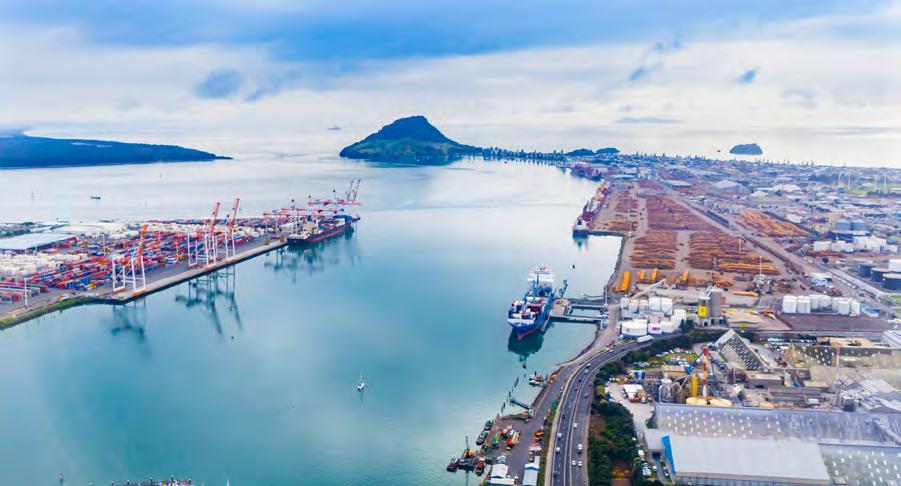
Supply chain disruption continues to have a massive impact on our ability to deliver an efficient service for importers and exporters. We have done our best to incentivise smooth cargo flows and the financial results reflect that.” – Port of Tauranga chair, Julia Hoare
domestic shipping network. Issues around weather in Australia and challenges portside here have meant the vessels due to participate have been delayed, with improvements unlikely until November.
Hoare also pointed to delays in resource consent for an additional container ship berth as contributing to efficiency issues.
Despite detailed planning and consultation beginning almost four years ago the port was unsuccessful in getting its application fast-tracked under government Shovel Ready projects during the pandemic.
A delayed Environment Court hearing is scheduled for early March next year. “It is incredibly frustrating after years of consultation and planning to be still ‘on hold’. Had we not




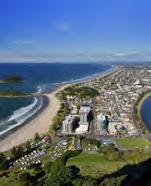



had these delays, we would be finishing construction now,” said Hoare. Port of Tauranga Chief Executive, Leonard Sampson, says the Port’s diversity of cargoes and long-term freight agreements with key customers has given some certainty through extremely challenging times.
“We are looking forward to a longer-term solution in the form of additional capacity at the container terminal, and soon at the Ruakura Inland Port that we are developing in Hamilton in partnership with Tainui Group Holdings.”
The inland port, part of the Ruakura Superhub, is due to open in late 2022 and will connect Waikato importers and exporters with the “big ship” services calling only at Tauranga.
www.bopbusinessnews.co.nz
CONTACT INFORMATION
PUBLISHER
Alan Neben, Ph: 021 733 536
Email: alan@bopbusinessnews.co.nz
EDITORIAL
Alan Neben, Ph: 021 733 536
Email: editor@bopbusinessnews.co.nz
PRODUCTION – Copy/Proofs/Graphic Design
Times Media – Clare McGillivray
Email: clare@times.co.nz
ADVERTISING
Pete Wales, Mob: 022 495 9248
Email: pete@bopbusinessnews.co.nz
ELECTRONIC FORWARDING
EDITORIAL: News releases/Photos/Letters: editor@bopbusinessnews.co.nz
GENERAL INQUIRIES: info@bopbusinessnews.co.nz
Bay of Plenty Business News has a circulation of 8000, distributed throughout Bay of Plenty between Waihi and Opotiki including Rotorua and Taupo, and to a subscription base. www.bopbusinessnews.co.nz
Bay of Plenty Business Publications
309/424 Maunganui Rd, Mt Maunganui, 3116
Bay of Plenty Business Publications specialises in business publishing, advertising, design, print and electronic media services.
THE PORTER REPORT
Long live the King
World coverage of Queen Elizabeth’s recent death and the ascent of her son – finally – to lead the British monarchy as King Charles III, has dominated the media.
The outpouring of coverage caused me to re-examine my own modest personal experience of Charles when he toured New Zealand as a prince with his then new bride Diana in April 1983.
As a young reporter, I was experiencing my first exposure to the demands and expectations of being a travelling news correspondent.
By the time the royal couple reached New Zealand, they had already experienced a month of ‘walkabouts’ across Australia, accompanied by the royal train. This was a tour group of officials, bureaucratic flunkies and a ‘royal rat pack’ of mostly British journalists.
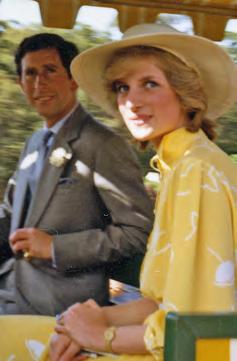
ship would be to get the press largely on her side in the palace wars.
One of the charming aspects of the 1983 royal tour – especially for the British press then – was that they were actually privileged to speak directly (for approximately a minute or so) to each of the royals at a welcome function in Auckland.
Direct conversation with the royals was otherwise then very strictly controlled by Charles’ public relations manager.
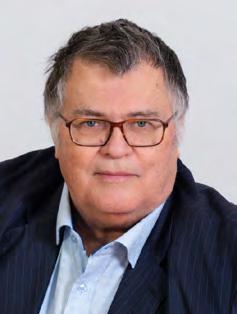
British press has taken some years to come to terms with his current wife, though it seems to have now been largely won over.
He apparently had a staff of around 30 as prince and his travel ventures reportedly require a specific list of personal items.
I can recall very little of my own truncated conversation with Diana. But I do recall coming away from my chat with Charles thinking he really was quite an interesting man.

In case you missed last month’s edition Scan to subscribe

And as could easily be observed, it wasn’t the millions of handshakes and camera flashlights that affected Diana, but rather an early realisation by her – and the crowds – that her celebrity power way outstripped that of her husband. As was soon to prove the case for their marriage in what eventually became a battle with much of the rest of the royal family.
She became an adept embracer and manipulator of the press, before her own sad
demise in a Parisian car crash. I in no way blame Diana for her approach. Although in those early days in New Zealand the royal couple seemed happy enough, she was clearly adjusting to the fact that marrying into the royal family wasn’t necessarily an easy road to tread.
Diana was, in my view, already a natural with the media. She seldom entered a room or hit a street on that tour where she had not already carefully worked out how she could present her best angles to the camera. She realised very early on what the best relation-
He responded to my questions on how he handled the repetitions of royal walkabouts in a way that struck me as refreshingly straightforward. It was, he remarked to me, “very difficult to find anything new to say”.
Whoever was writing his set-piece speeches for him during the 1983 tour seemed to do a solid job as these were usually interesting and apposite.
Charles has stumbled frequently in the media, and the
ICONS NEVER REST
According to Tina Brown’s new book, “The Palace Papers,” on his visits, the Prince of Wales brings an orthopedic bed, a lavatory seat, toilet paper, and two paintings of Scottish landscapes. Who wouldn’t?
The fact that Charles and his family enjoy millions in essentially unearned income from their inheritance of centuries of property ownership leaves them somewhat out of touch with everyday reality. Nonetheless, insofar as any member of his family ever does, he often speaks his mind. Charles has waited a long time to become king, and I trust he enjoys his long-awaited role. It will be an interesting reign. Long live the king.

The 2023 RX continues to raise the bar with an all-hybrid range.
The RX 500h F SPORT Performance combines a new advanced 2.4-litre turbocharged hybrid powertrain, six-speed automatic transmission and DIRECT4 all-wheel drive system with a driver-focused Tazuna interior.
While the RX 350h brings unparalleled efficiency, refined comfort, and nimble handling for an amazing experience.
Register your interest today.
David Porter
Porter
The royals on the 1983 tour of NZ and Australia.
Urban Task Force explores construction supply issues
Continued from page 1
“Immigration New Zealand’s system is not working the way it should and applications are getting hung up,” Urquhart noted.
She observed that the problems and delays are resulting from the obligatory job checks – the stage at which checks are made to prove no New Zealanders are available to do the job – taking so long, delaying the migrant’s ability to apply. This has been exacerbated by new system failures.
Although immigration New Zealand originally announced the first two stages, employer accreditation and job checks, would be completed in under 10 days, this target has been abandoned and they now won’t even provide a timeline.
Willy Bedford from Venture Developments focused on his organisation’s experiences with residential housing and construction trends, particularly challenges to the market from climbing interest rates, property prices and escalating building costs, driven by increased consenting, material and labour costs. “All of this has resulted in significant increases to square metre rates”, he said.
Bedford calculated that building costs have increased from approximately $3000 to $4000 per square metre over the last 18 months. As a result, fixed-price building contracts
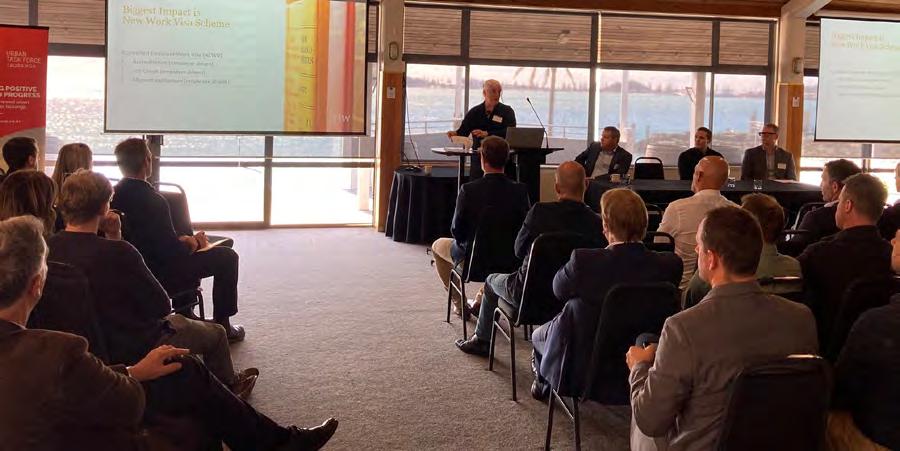
have become increasingly hard to promote.
Bedford identified opportunities for developers to work collaboratively with the parties to achieve improved housing affordability.
Hawkins’ Peter McCawe highlighted escalation challenges his organisation has encountered in the commercial construction sector recently.
He described the ‘perfect storm’ caused by Covid, overlapping three areas: the loss of production time as
a result of lockdowns; Shipping and transport cost increases; And continued high demand for materials and human resources.
“From a commercial construction perspective, we don’t see things slowing down. Although the escalation will become less volatile, it’s not going to go into the negatives”, he warned. “Costs will not, unfortunately, decrease – only the rates at which they increase will slow down.”
McCawe illustrated the problems identified by Urquhart for employers
in the construction sector securing human resources from abroad. He described how, despite a recruitment drive in March when the borders opened that involved a trip to the UK where 50 prospective employees were interviewed and 25 offers made – to date only three have finally landed in New Zealand.
His message to employers: “Ensure that remuneration is competitive, you’ve got a healthy team culture, and that you’ve got flexible working arrangements.
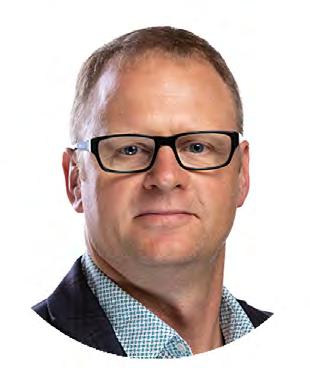
From a commercial construction perspective, we don’t see things slowing down. Although the escalation will become less volatile, it’s not going to go into the negatives.”
– Peter McCawe
Seeka releases Sustainability Report
Carbon footprint independently verified Targeting 30% reduction in carbon emissions by 2025.
Listed produce company, Seeka
Limited released its first comprehensive Sustainability Report in June. Seeka’s Sustainability Report 2022 focuses on establishing the base methodology for Sustainability Reporting including three years of independently verified carbon footprint calculations.
The report outlines the initiatives and targets that the company is putting in place to measure its sustainability performance and its initiatives to respond to climate change.
Seeka has established a goal of being net zero carbon by 2050 through
initiatives including waste reduction, regenerative orchard practices, being an employer of choice and supporting the wellbeing of local communities.
Seeka Chief Executive, Michael Franks, outlined that the report is a significant step forward for the company. It establishes Seeka as a socially and environmentally responsible company in each of the regions. Seeka has committed to reduce its verified carbon footprint by 30% by 2025 and 50% by 2030. Following the plan, the company has established the target of being net zero carbon by 2050.
In addition to reporting absolute carbon results, Seeka is benchmarking intensity-based performance indicators to capture efficiency gains as the business grows.
Franks explains, “We operate in fast-growing industries, and we intend to continue expanding through a planned increase in New Zealand kiwifruit crops. We are measuring the carbon impact of fruit handled by Seeka, which at 50.7 tonnes of C02e per 100,000 class 1 trays packed is trending down over the past three years, demonstrating early gains from our carbon reduction initiatives.”
Seeka 2022 sustainability highlights:
• Carbon footprint assurance for 2019, 2020 and 2021 by Toitu Envirocare
• Assisting iwi to achieve improved economic enablement through the joint development of their land
• Recovering strings from 150 hectares of SunGold kiwifruit orchards, recycled and diverted from landfill
• Growing the Pacific economy with 781 Pacific people supported
into seasonal employment in 2021 through Seeka’s recognised seasonal employer programme
• Capacity for 446kW of solar power with systems installed in Seeka Kerikeri, Seeka Australia and Seeka 360 in Te Puke
• 100 tonnes of organic waste able to be diverted to regenerative horticulture; composted at Seeka’s worm farm and applied to Seeka orchards
• Six hybrid vehicles joined Seeka’s fleet
• $270k donated to charity, sports groups and local organisations
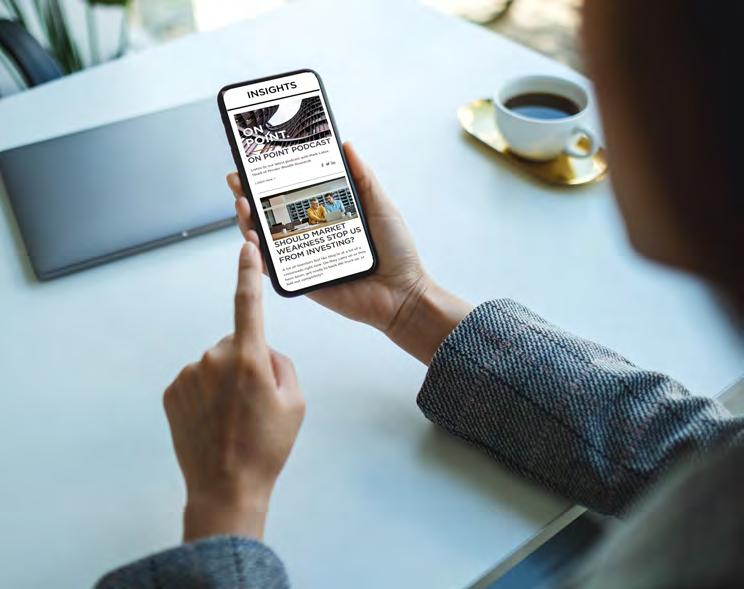
TomkinsWake’s immigration specialist Michelle Urquhart explains the requirements for employer accreditation. Photo/Supplied.
Proposed GST change gone by lunchtime: public opinion can count
The Tax Bill introduced in August got more than its fair share of attention for all the wrong reasons. The press release by officials highlighted the planned FBT exemption for employer subsidised public transport, which is only expected to provide about $9 million in benefit to employers in terms of reduced FBT collected, but this was largely overlooked by press and commentators.
Unless you have been hiding under a rock you will know that the part of the Bill that caught everyone’s attention was the proposed imposition of 15% GST on fund manager fees. While this was intended to bring some certainty and consistency to the way in which GST is charged by fund managers, which is arguably a good outcome, the modelling suggested that by 2070 this would reduce total Kiwisaver investor funds by approximately $103 billion.
To put it in context, this is only about 4% of the total forecast value of funds invested, but the outrage was such that the proposal was literally gone by lunchtime and the Bill has been reissued without these clauses.
Another part of the Bill which has not received a lot of attention in the media is the changes around the platform economy. The Bill contains two separate changes, which apply to different parts of the
platform economy:
1. Extending the existing GST marketplace rules to capture accommodation, ride-sharing, and food and beverage delivery services provided through electronic marketplaces.
2. Implementing an information and reporting framework that will require New Zealand-based digital platforms to annually provide Inland Revenue with data about sellers. Platforms that are in scope are any that have sellers in the following sectors:
a. Rental of immovable property (including commercial, short-stay, and visitor accommodation); b. Personal services (including any time- or task-based work);
c. The sale of goods; and d. Vehicle rentals. The first of these changes will require the digital platforms to return 15% GST on short stay accommodation,
The bill requires digital platforms offering ride-sharing, food and beverage delivery and short stay accommodation to return 15% GST.
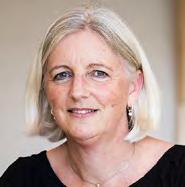
TAXATION
>
BY ANDREA SCATCHARD
Andrea Scatchard is a Tax Partner at Deloitte, based in the Bay of Plenty. She can be reached on ascatchard@deloitte.co.nz

ride-sharing and food and beverage delivery services, even if the supplier of those services is itself GST registered and currently returning GST (these will become zero-rated supplies for the supplier). Suppliers that are GST registered will still be able to claim GST on their costs as they currently do, so there should be minimal
overall impact for them, just a new layer of complexity.
Where the suppliers are not GST registered, the digital platform will be able to claim a notional input tax credit of 8.5% on behalf of the supplier meaning that the net GST payable by the platform will be 6.5%.
The platform must then
pass on the 8.5% credit to the underlying non-registered supplier as cash. For the large number of taxpayers whose turnover is under $60,000 or who have chosen not to voluntarily register for GST, this will be a big change and represents an overall reduction in return for the supplier which may well be passed on in the form of increased charges to consumers. Inland Revenue estimated this additional cost to consumers to be $47 million per year.
The second change will require New Zealand based digital platforms to collect and report on the identity, residence and sales information for sellers using the platform for the relevant types of supplies.
Where the seller is a New Zealand resident, we expect Inland Revenue will then use that information to check whether the seller has returned that income for tax purposes.
Where the seller is not a New Zealand resident the information will be passed on to the relevant tax authority overseas. While New Zealand resident sellers who use overseas based platforms to sell goods and services are not directly affected by these changes, it is most likely that the platforms will be required to report the equivalent information in the jurisdiction that they are resident and that information will end up in Inland Revenue’s hands in due course. These proposals, and the many others that are included in the Bill, are open for consultation for the next few weeks. The turnaround on the GST on fund management services shows that public opinion can count, so if you would like to make a submission, or if you just want to know how these changes might affect you, get in touch with your accountant or tax adviser.

Building employee self-confidence
A recent Dale Carnegie study found that, “Confidence is the emotion that empowered employees value most highly.” When employees are self-confident, they perform at a higher level, show better engagement, and are more creative. But confidence is a skill that many people need to work on, even more so after the shocks of the pandemic.
Like self-awareness, self-confidence is one of those game changing competencies. Having a greater belief in yourself and abilities completely changes what you can see yourself achieving. I remember in my late 20’s finally heading overseas for my “OE”. This was a 6 week see the world” every day planned tour of the UK and Europe. I remember watching in amazement as several of our group left the Contiki tour in Paris before the bus returned to London.
Where would they go?
Reasons employees may not be confident at work

EDUCATION AND TRAINING
> BY MICHAEL SHAW
Michael Shaw is managing director of Dale Carnegie BOP Waikato (www.bop-waikato.dalecarnegie.com). He can be reached on Michael.shaw@dalecarengie.com
I wondered. Ten years later after quite a lot of professional development my wife and I arrived in Bangkok with nothing planned but one night accommodation and a 12month round the world ticket. Nothing was a problem anymore. So why do we lack confidence?
45% of employees say their work doesn’t provide enough job support training and skill development opportunities. Lack of self-confidence stems from not knowing what you’re doing.
• Lack of Job-Specific Knowledge & Training Opportunities According to a 2018 study, 32% of workers felt underqualified for their current role in the previous year. As time has progressed and work has become remote, hybrid, and filled with AI, workers feel even more unprepared to fulfil their job requirements, and
• Poor Management Style Unfortunately, managers and bosses have a significant impact on employee confidence. A boss who lacks empathy may be unintentionally harsh to an employee about a mistake or when giving constructive feedback. Managers also might fall into micromanaging, taking decision-making power out of the hands of the worker. This can cause confidence in the workplace to decline significantly.
• Company Disarray
The company’s culture, policies, mission, and future are all important considerations. If any of these are in disarray, employees will disengage. According to Gartner, 52% of employees strongly agreed that the pandemic has caused them to question the purpose of their jobs. A clear company mission that employees can connect with means those employees will have an innate desire to complete their work and do it well.
Six ways to boost employee self-confidence
Knowing how to boost someone’s confidence is a key trait of leaders, managers, and
executives. Here are 6 ideas for how to boost employee confidence:
• Recognition: Take the time to recognise someone’s efforts and contributions, even if they resulted in a negative outcome or their idea wasn’t chosen.
• Offer Assistance: Knowing that help is available on a project can relieve pressure and increase confidence.
• Cultivate Psychological Safety: As leaders, it is our responsibility to create a culture of psychological safety within the organisation and teams, so employees will feel more supported in speaking up and sharing their ideas.
• Provide Training: From on-the-job skills training to a
course specifically designed to raise self-confidence, resilience and interpersonal skills.
• Listen: Sometimes, all it takes to create an atmosphere of openness is listening to that person, whether it be in a meeting with an idea or during a one-on-one call.
• Delegate and Empower: Employees, must step up to the plate when given responsibilities, which pushes them slightly outside of their comfort zone, which is how they gain confidence.
Building confidence at work, not only increases the value and resilience of your business, but the ripple effect also flows onto family and community.
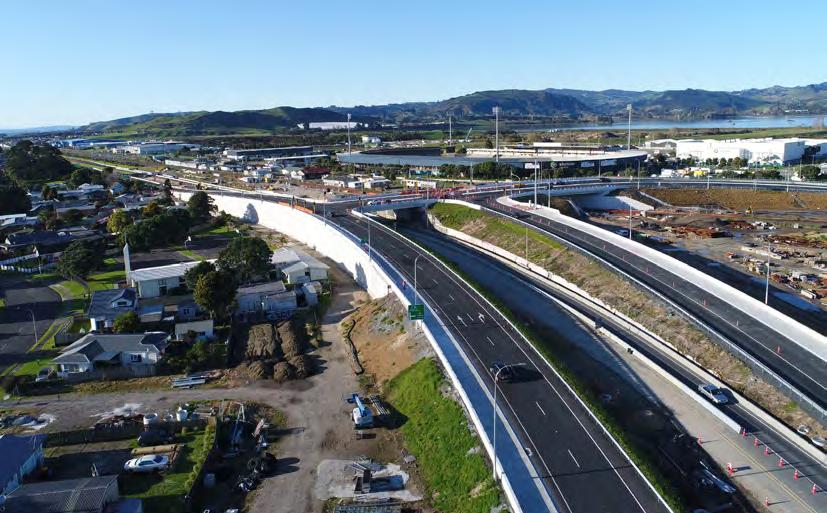
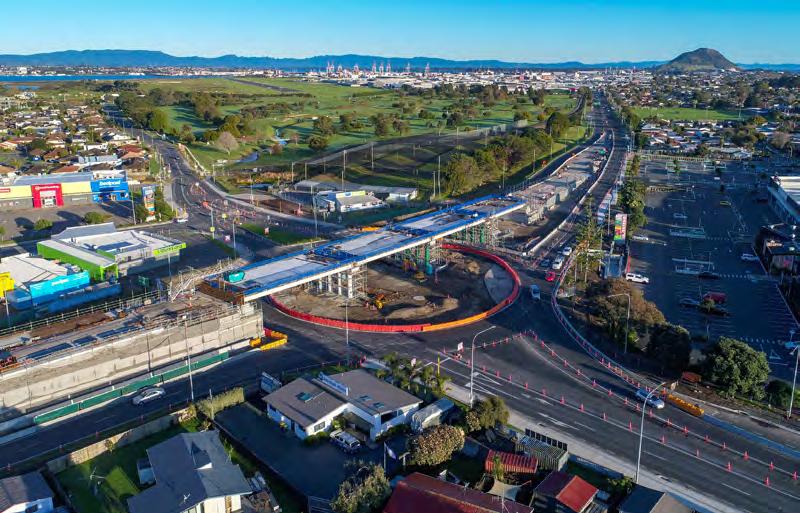
Late 2023 date firm for Baypark-Bayfair link opening
For Jo Wilton of Waka Kotahi, and most of the Bay’s motoring public, next Christmas will not be arriving soon enough. Next December marks the planned opening of the Baypark to Bayfair Link roading project separating local, state highway and rail traffic, to complete the state highway two eastern corridor system.
By RICHARD RENNIE
While uncertain about the $260 million dollar project’s absolute final cost, as regional manager for infrastructure delivery Wilton has confirmed December 2023 is a “definite yes” for its opening date. Having commenced in 2015, the 1.7km stretch of highway marks one the most expensive projects undertaken in recent years for its relatively short length, with one of the longest construction periods.
For a cost comparison, the Tauranga Northern Link (TNL) at 6.8km has been costed at $655 million. Over the Kaimai range the recently opened
22km of the Hamilton expressway was completed on time and under budget at $800 million. The completed Hamilton and Huntly sectors of the Waikato expressway total 37km and were also both started in 2015.
The opening date for the Baypark-Bayfair project was pushed out two years when an extended pedestrian underpass was retrospectively added, also adding a further $26 million to the bill. The underpass will enable pedestrians to move under both Maunganui Road and SH2 and construction is expected to be ongoing while it is also in use.
However, Wilton said the underpass’s construction also necessitated
some major additional geo-technical work when previously undetected pumice deposits required extra underground strengthening.
The project’s original quoted construction cost was $120 million, but Wilton said that had failed to include the costs of purchasing adjacent properties, while the additional below ground strengthening work and underpass had also added to costs.
But she has been heartened by the visible above-ground work now moving at pace on the project, including the installation this winter of bridge beam installations at both the northern end at the Bayfair flyover, and the second state highway 2 bridge.
Spans for the Bayfair flyover have also been installed between April and August. In total 46 locally manufactured bridge beams, often weighing up to 54 tonnes have been placed.
Permanent concrete barriers have also been poured in recent weeks around the base of the flyover’s southern ramp using a machine that shapes fresh concrete and forms the barriers in its wake.
Two lanes on Girven Road between Bayfair roundabout and Gloucester Road are also expected to be restored and the shopping centre’s first Girven Road entrance and footpath in the area is due to be completed by late September. Work is also continuing on the Truman Lane walking and cycling connections, the Papamoa off-ramp and state highway road under the interchange.
Wilton said every roading project has its own unique challenges, but for the Baypark-Bayfair project the
fact it is a “brownfields” project was one of them. “Working in an existing corridor that already has traffic and services, a state highway that cannot be closed makes work progress more challenging. Staging your work has to be done carefully, and safely for workers and motorists.”
She said given a choice any engineer would prefer a “greenfields” project, such as most of the TNL and Waikato Expressway projects have been. Traffic volumes through the site are significant at about 36,000 a day, less than the Auckland motorway peak but ahead of Waikato Expressway at 25,000 a day.
Once fully opened the project will facilitate the seamless movement of traffic coming from the Tauranga Eastern Link (TEL) into Mount Maunganui or via state highway 29a to Tauranga, with separation from the rail line and between local and highway traffic.
Success for Scion in latest funding round
Two innovative Scion research projects will receive investment funding totalling $1.9 million over three years through the Ministry of Business, Innovation and Employment’s 2022 Endeavour Fund.
Scion scientists will also contribute their expertise to a further six projects involving other research organisations that secured Government support from the Endeavour Fund – Aotearoa New Zealand’s largest contestable research fund.
The successful science projects were announced by Research, Science and Innovation Minister Hon Dr Ayesha Verrall yesterday.
Endeavour funding for the two successful Scion projects will come from its Smart Ideas investment mechanism. Smart Ideas are intended to catalyse and rapidly test promising, innovative research ideas with high potential for benefit to New Zealand.
One pioneering Scion project, in partnership with the University of Cambridge, ‘Implanted sensors monitoring tree health and carbon capture efficiency’, will receive $1 million over three years to design sensors to measure the nutritional status, vitality, carbon capture efficiency and microbiome fitness of growing trees.
Precision forestry uses remote sensing tools such as satellites and drones, combined with sophisticated sensors, to detect subtle variations in plant health, nutrient and water status.
Monitoring the physiological pro-
cesses inside trees in real-time is the only way to fully understand how trees are responding to the environment around them and to future-proofing their resilience to climate change.
To implement this in practice, Scion will develop sophisticated low-cost bioelectronic sensors which can be implanted inside trees. These types of sensors have been used in biomedical research – but rarely used inside trees for forestry. Their use in New Zealand radiata pine will be pioneering.
Data generated by these sensors will be transmitted from the trees via a wireless network in the forest.
Fusing data from remote sensing together with physiological sensors within trees, combined with genome and climate data, can provide the most complete insights into a growing forest anywhere in the world.
Successful too, was the Scion proposal, ‘Plant-inspired 3D-printed scaffold for tissue culture’. Awarded $900,000 over three years, Scion scientists will explore new technology that aims to improve the tissue culture technique that makes clonal forestry possible in conifers.
Commercial forestry relies on producing vast numbers of trees – often elite clones. Somatic embryogenesis
is the tissue culture technique that is used to create embryos for this purpose, but it has some limitations.
Somatic embryos can have trouble maturing on a flat surface – effectively when they are sitting on a dish on a laboratory bench. In nature, these embryos would mature in a complex three-dimensional structure as they interact with other cells and respond to different gradients and signals of temperature, mechanical force, nutrients and plant hormones.
Replicating this environment is extremely challenging in the laboratory, yet it is the key to successful tissue culture.
This project will adopt sophisticated 3D printing techniques using hydrogels to create a scaffold with gradients of hormones, nutrients and porosity along its length. To visualise this scaffold, imagine a large cardboard tube with round holes in the sides and complex gradients of hormones and nutrients along its length.
While the immediate application is in the forestry industry, the same technique can be applied to other plant species, mammals and create new biomedical opportunities.
Science leaders at Scion will also contribute to six collaborative projects that received a total of $5,754,700
At Scion, we’re proud to lead research that will unleash the power of forestry, tackle climate change and help transition New Zealand to a circular bioeconomy.” – Dr Julian Elder
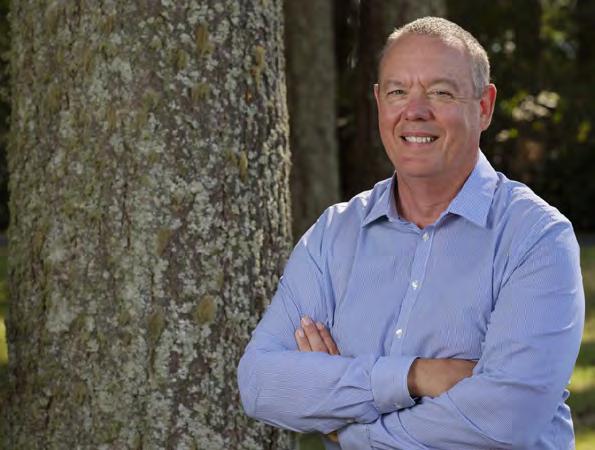
from the Endeavour Fund. They involve joint research with Auckland University, WSP Research NZ Ltd, Manaaki Whenua – Landcare Research, Lincoln University, Auckland University of Technology and Massey University.
Scion chief executive Dr Julian Elder says yesterday’s announcement is fantastic news for the Scion teams who were successful in securing funding.
“We’re delighted with the funding win, which acknowledges the value that we know forests can contribute to a more prosperous economy and healthier environment.
“Forests will be at the heart of a low-carbon future New Zealand. At Scion, we’re proud to lead research that will unleash the power of forestry, tackle climate change and help transition New Zealand to a circular bioeconomy.
“I congratulate all the funding recipients and look forward to supporting our teams as this important research gets underway.”
The Endeavour Fund supports excellent research with the potential to positively transform New Zealand’s economy, environment and society. This year a total of $236.5 million has been allocated to 71 projects.
Left:The Baypark end of the Baypark-Bayfair Link project. Right:View of Bayfair roundabout and interchange on Baypark-Bayfair Link project.
True business wealth?
It’s only a matter of time
Against a backdrop of global economic compression, political uncertainty and widespread talent shortages, learn why right now is the perfect opportunity for smart business leaders to enjoy the time of their lives.
It’s slipping through our fingers, and we don’t even realise.
We know time is short. Yet we take no meaningful action to make the changes we seek in our businesses and our lives.
You know this. I know this.
But our words betray our thoughts.
Don’t believe me? When someone asks you how your week is going, how often do you reply “busy”, without even pausing to think? How recently have you said something along the lines of “I can’t believe how fast this year is flying by”?
Time speeds up, yet we stand still.
I speak to hundreds of business owners every month, and most of them say the same thing: “Not enough money. Not enough talent.”
But what if money and talent weren’t the real issue?
What if TIME was the solution you really needed?
Queen Elizabeth, Steve Jobs, Henry Ford, Kobe Bryant: All had bucketfuls of money. All had an endless talent pool of resources to call upon. All ran out of time.
But what if I could give you more time?
What if I could show you how to achieve more with less?
How much richer would your days be?
Give me five minutes, and I’ll give you your life back. You’ll never find the time
I don’t care how wealthy or successful you are, you’ll never ‘find’ the time for anything. If you want time, you must make it.
How do you make time? Ironically, you make time by slowing down.
You slow down by prioritising yourself. This means stop putting your calendar in abusive charge of your life and stop letting other people use you.
This will probably feel selfish at first, so let’s hammer home the point by showing you the evidence in black and white. Or – to be precise – red and green. Let’s do an experiment. Go to your work calendar. Print off two copies of this week’s diary. If you live in the modern world and do things digitally, then do this activity online. If you’re too busy (ahem), then do this in your mind’s eye. Take a red pen. In the first copy of your calendar, scribble red anything where you are NOT directly serving (i.e talking to) a money-paying

MINING BUSINESS WEALTH
> BY FREDDIE BENNETT
Guinness World Record Holder, podcast host and bestselling author, Freddie is known as ‘The Profit Hunter’. He helps business owners enjoy more time, money and freedom by discovering and extracting hidden profits in their companies. Freddie@conqueryourmedia.com

customer or client. That means coffee catch-ups, internal meetings, training sessions, weekly updates – all of it gets the crimson crayon treatment. Next, take a green pen. In the second copy of your calendar, scribble green any activity that you LOVE to do. Don’t BS me that you love budget meetings. I’m talking about the set-your-soul-on-fire, can’t-sleep-because-I’m-tooexcited stuff that truly lights up your life.
Look at how much red is on your calendar.
Then look at the amount of green.
Then try to tell me you’ll never find the time to fulfil your business and life ambitions.
The harsh truth is this: You do have the time. You just give it to other people.
Killing Time
There is no greater time waster than pleasing people. I’m not just saying that because I’m an awfully polite British chap. Over my years advising clients on performance, mindset and productivity, the deeper we dig, the more the desire to please others reaches the surface.
Phone rings. Answer it.
Email pings. Read it.
“Have you got a minute?” Take as many as you want. It’s so easy to fill our days with the arduous task of winning the approval of others. Answering every call. Fulfilling every request. Interrupting
ourselves and our own dreams over and over again.
Then we wonder why our first feeling every morning is: “I didn’t sleep enough”.
And our last thought every night is: “I haven’t done enough”.
That’s why the amateurs of this game talk about ‘Time Management’. But it’s not management. ‘Management’ is a safe-word in the dungeon where our true potential gets tied up and blindfolded.
This is about Time Leadership. Leaders are ruthless when they need to be. A leader will cut away beliefs and perceptions that another person’s time is more important than their own.
A leader understands that their life is theirs. But it doesn’t just arrive. It must be created.
The Business of Busy-ness
Of course, we are faced with something of a time-pressured dilemma.
If you’re running a business and you empower your teams to be selfish with their time, you won’t have a business. Because everyone will be declining meeting requests and skipping down Papamoa Beach, having the time of their lives while shouting “But Freddie Bennett told me I was a Time Leader!”
So you must teach your people how to make more time.
First, give them the breath-
Are there other ways to get our city moving?
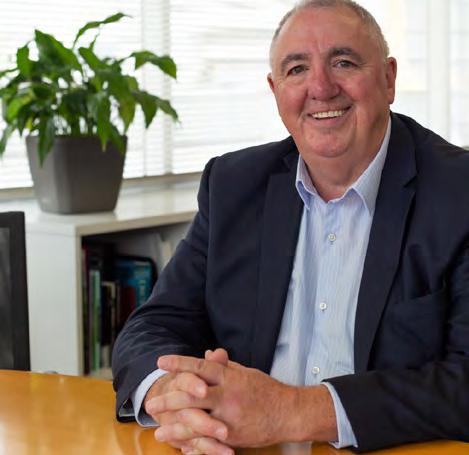
By STEPHEN SELWOOD, Tauranga City Council Commissioner
Tauranga City Council has close to $2 billion earmarked in its 202131 long-term plan for transport system improvements, with the aim of getting traffic on our roads moving more freely. That includes a significant investment in public transport and walking and cycling assets, to encourage mode shift away from motor vehicles.
ing space to do their jobs. Efficiency studies have shown that one hour of uninterrupted work time is worth three hours of distraction-filled time.
Next, you can stop your teams feeling overwhelmed. Help them remove regrets about previous projects or worries about future initiatives. Remind them: All that matters is today.
Finally, lead them to understand that so much time is wasted with frustration, upset, anger, gossip and fear. But situations at work (e.g dysfunctional teams, angry customers, power-tripping leaders) don’t directly create these life-sucking, time-burning actions. It is our interpretation of these events that does the damage.
Our time is only wasted by our thoughts about and reactions to incidents – never the incident itself.
The Perfect Moment
So the next occasion you’re wasting time living someone else’s dream, remind yourself of your role, your plan and your priorities.
My dad once said to me: “Stop stressing about creating a perfect year – just create a day. Define your perfect day and start living it. The year takes care of itself. So will your business. So will your life.”
Then one day, he died. So never had the opportunity to enjoy the time of his life.
But you do.
If you’re not too busy, that is.
Despite that, modelling indicates that our increasing population will see vehicle numbers on our roads continue to increase, with a 14% increase by 2028 (compared to actual vehicle numbers in 2018) and another 23% increase on top of the 2028 number by 2048. If those estimates are accurate, more of our key arterial roads will be impacted by even more serious traffic congestion at peak travel times, with all of the impacts that has upon our lifestyle, economy and environment.
So what are the solutions?
We’re already focusing on better land use – essentially encouraging housing intensification around our existing commercial centres and along the Te Papa peninsula (so people don’t need to use a car to access their workplace or the services they need) –as well as introducing smart transport systems (synchronised traffic lights, etc.) and better prioritised investment to address existing bottlenecks. But the fact is, we will still need a step change so we can make the best use or our road network and accelerate the move away from private vehicles as our primary transport option.
One possibility which has been effective in reducing congestion in other parts of the world (notably Singapore, Stockholm and Gothenburg, ) is ‘road pricing’. Effectively, this is a variable charge levied on vehicle owners who choose to use a
particular route at a particular time of the day, which encourages individuals and business owners to think about how and when they use the transport network.
For private users, this might involve choosing another transport mode, working from home, sharing a trip, or choosing another time of day to travel around the city, for example. For business users, it might mean thinking about a different operating model, so that their vehicles aren’t on the road at peak travel times, or allowing more flexible working hours where this is possible.
Of course, no-one will be particularly keen to pay a new charge on top of their existing transport costs – we get that. But the advantage is that those who pay will enjoy a faster trip and the funds raised will be reinvested into a better transport system for Tauranga.
The reality is we’re already paying for congestion now and that cost will increase, substantially. As individuals, continually sitting in slow-moving lines of traffic means we have less time to spend with our whanau and doing the things we like. For businesses, it means increased vehicle and salary costs and reduced productivity. And for our environment, it means more carbon emissions contributing to climate change.
In short, we have to make a choice – keep doing what we’re doing now and accept the cost that imposes on all of us, or start thinking seriously about a game-changer. There may be other possible solutions too, but we know that road pricing works and we know that it’s technically feasible right now.
The Tauranga City Council Commissioners think it’s timely to start a conversation about the pros and cons of road pricing, because the sooner we start to change, the better it will be for everyone who lives or does business in our city.
Stephen Selwood
What are small business owners experiencing at the moment?

DWORKPLACE WELLBEING
> BY BRIDGET SNELLING
Bridget Snelling, Xero New Zealand Country Manager.
ue to inflation, we’ve seen the rising cost of living impact small business sales as households tighten the purse strings on discretionary spending.
Simultaneously, there are growing expectations for salaries as the local labour market tightens and wages growth reaches record levels.
For Bay of Plenty small business owners feeling the pressure, you’re not alone, and there are really clear steps you can take to navigate the current economic climate.
New findings in the Changing world of work report released at Xerocon in September shone a light on the plight of small business owners in Aotearoa, with a third (36%) saying that managing employee processes is negatively impacting their mental health.
The impact of inflation on costs and services was front of mind with 65 percent of
employers saying the current climate was a major cause of stress – especially with Aotearoa’s inflation hitting a 30 year high of 7.3 percent in July this year.
This is compounding with labour shortages as 43 percent of small business employers see talent shortages as the biggest challenge facing them.
Employers are expecting to pay top dollar to attract employees, with the research showing a third of employers believe a rise in salary expec-
tations (37%) and staffing costs (34%) will be among their biggest challenges.
So what can small business owners do to navigate the future without experiencing burnout themselves?
Findings from the report show that small business employers in Aotearoa are planning to hire three staff members on average over the next 12 months.
In order to attract and retain talent, almost a quarter of employers have recently
We all must find ways to work smarter, not harder – using technology to automate and make admin tasks more efficient. We need to ensure every hour spent working is doing something only a human can do, especially considering the ongoing labour shortage.”

invested or are planning to invest in higher pay across all staff (23%) and empower employees by improving the overall workplace technology experience (23%).
Businesses that continue to ignore digital tools risk being left behind.
We all must find ways to work smarter, not harder –using technology to automate and make admin tasks more efficient. We need to ensure every hour spent working is doing something only a human can do, especially considering the ongoing labour shortage.
With the numerous challenges around us at the moment, this is something small businesses can do right now to make things a little easier.
This doesn’t have to revolutionise how you do business – rather pick one or two pain points and talk to your accountant / bookkeeper to see if there are digital tools or apps out there to make things a little easier.
Together we can help small businesses recover and thrive long-term, as well as build more resilience, diversity and depth into the economy.
And if you need support now?
The Xero Assistance Programme provides free and confidential wellbeing support to more than one million New Zealand small business owners, their employees and families.
If you’re a Xero subscriber, you and your employees have access to face-to-face, telephone, live chat and online counselling to address specific problems.
To get started, email the Xero team at xap@xero.com for next steps.
team.
teams to get the best possible outcome for our clients.
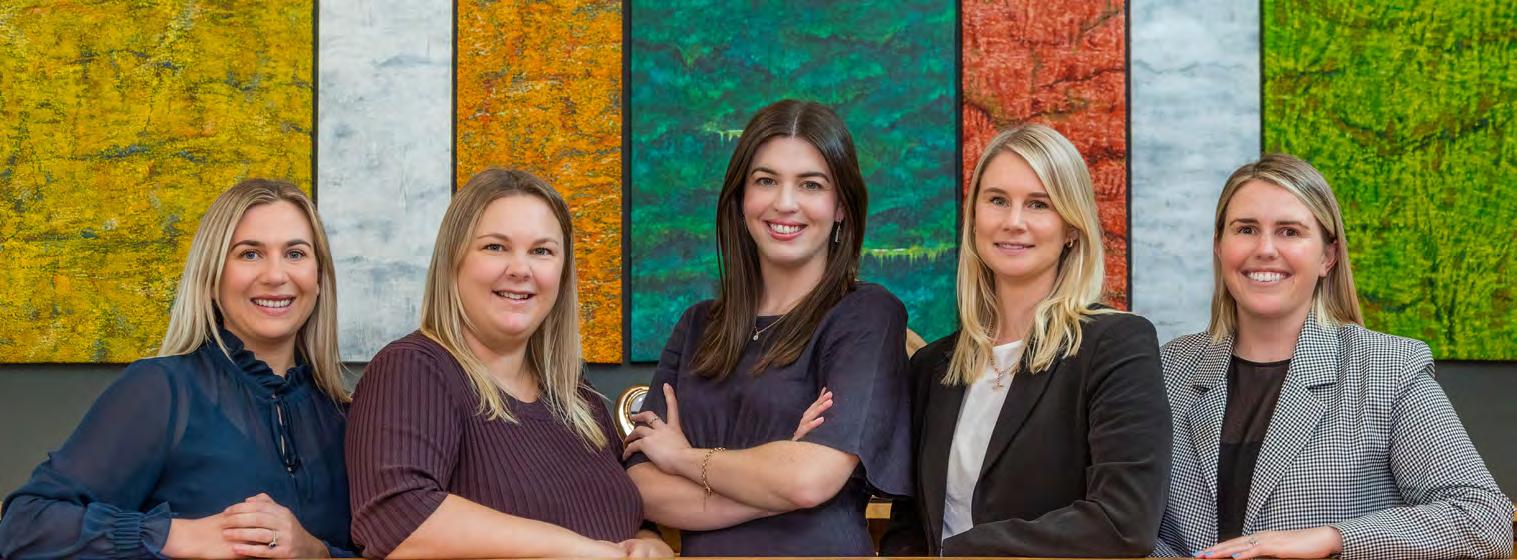
hobec.co.nz
Game-changing performance hybrid SUV
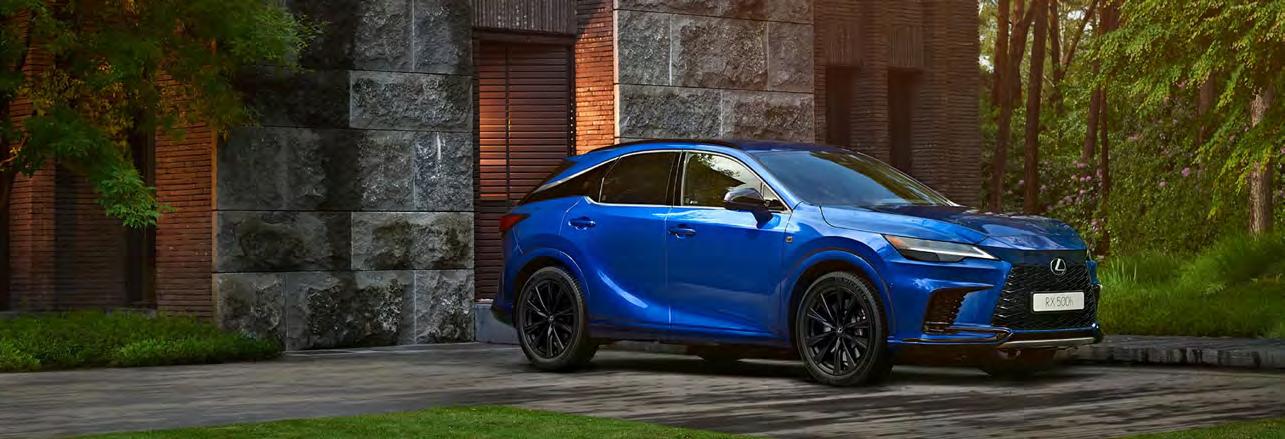
In the automotive world, you’re only original until others catch up. In 2005, the Lexus RX was original, being the first ever petrol/electric hybrid-powered luxury vehicle. It was revolutionary for laying out the framework for what a luxury SUV could be.
While the competition followed the traditional method of building an SUV, the Lexus RX shattered the mould of what an SUV could be. The Lexus RX delivered a car-like driving experience, greater performance, improved fuel economy and significantly reduced emissions. In 2005, it changed how customers viewed luxury vehicles, convincing them that owning an SUV and a hybrid was worthwhile.
Fast forward over fifteen years and nearly every popular SUV has followed the Lexus RX’s original template, and SUVs are now more popular than ever with SUV sales topping more than 80,000 vehicles and accounting for 50% of total vehicles sold in New Zealand in 2021.
The options available are extensive with petrol, diesel, hybrid (HEV), plug-in hybrid (PHEV) and battery electric vehicles (BEV) for sale from roughly 43 manufacturers. So now that the competition has caught up, how does Lexus RX stay relevant and
become original again?
The all-new fifth-generation Lexus RX will become a pioneer once again with an evolution fit for an icon. When it arrives in early 2023, Kiwis will have the choice of two variants (with a PHEV coming later). A hybrid AWD model and a new range-topping hybrid performance model will be available at launch, it’s the performance hybrid that is the game changer for Lexus.
The all-new Lexus RX500h will signify many firsts for the brand. Lexus will debut the F SPORT Performance grade on the RX500h with a leading edge 2.4 turbocharged hybrid powertrain, giving a potent 274kW and 551 Nm, that’s more torque than the famous Lexus 5.0 V8! This powertrain combined with the new Direct4 AWD technology results in a more “natural” and almost instantaneous acceleration. To put it simply, it’s very quick.
The new RX500h isn’t simply about power and torque though, that’s not the Lexus way. There’s also

rear-wheel steering, adaptive damping, 400mm rotors and six-piston callipers up front. This all helps to provide a beautifully balanced vehicle with precise steering, perfect for New Zealand’s twisty and undulating roads. It’s also matched to a six-speed automatic transmission which means drive-feel has improved greatly as a CVT transmission is no longer required.
The sophistication of the vehicle continues inside as well, you’ll find
human-centred design surrounded by a plethora of leather, heavily bolstered front seats (with heating and cooling) along with a large 14” touchscreen display.
Rich-looking ambient lighting illuminates the cabin at night while a beautiful panoramic roof can let sunlight in during the day. A 21 speaker, Mark Levinson premium audio system provides theatre-like music in the ultra-quiet cabin. The feature list on the Lexus RX550h is almost end-
less, with each feature being the most premium version it could possibly be with Takumi craftsmanship at its heart. The RX500h is also extraordinarily safe, as safety was one of the hallmarks of its success and the new model is no different. A new iteration of Lexus Safety System+ debuts which includes motorcycle detection to go alongside the vehicle, pedestrian, and bicycle detection. Expect the maximum ANCAP safety rating once tested.
In short, the all-new Lexus RX is redefining the luxury SUV segment and raising the bar higher for the competition once again. Initial demonstrator models should be in New Zealand Lexus dealerships before the end of the year with customer deliveries anticipated to begin early 2023. Based on recent Lexus model launches (the smaller NX SUV and larger LX SUV) wait times will grow quickly once demonstrators are on the ground, so if you’re interested to know more, reach out to the team at Lexus of Tauranga and submit your expression of interest today.
Visit Mitchell at Lexus of Tauranga at 158 Elizabeth St, Tauranga – or call him on 07-577-0880
Bay business most optimistic – 2degrees study
A new 2degrees report reveals big business is thriving as SMBs struggle to keep up, while increasing costs are the leading issue for all businesses.
But good news for the Bay –the 2degrees’ latest Shaping Business Study found more than half (57%) of Bay of Plenty Business decision makers would describe their business as reviving at the moment. This compares to Auckland (52%), Canterbury (54%), Wellington (55%).
The report, conducted by Perceptive on more than 700 employing business decision makers around Aotearoa, found that different-sized businesses have had a significantly different experience over the past year, and identified more work benefits and flexible work as the key drivers of success in the current environment.
“Kiwi businesses are facing an incredibly challenging environment, but the effects aren’t being felt equally,” says Andrew Fairgray, Chief Business Officer at 2degrees.
“Costs are rising across the board, businesses are crying out for skilled staff, and Covid continues to present problems, but large businesses are weathering the storm in a way that smaller businesses aren’t.”
Outlook shifts according to business size
Only 36 per cent of business lead-
ers are feeling more optimistic about their business compared to a year ago, a drop of four percentage points from 2021. In contrast, 31 per cent were feeling less optimistic, and 33 per cent were feeling about the same.
Larger businesses are much more likely to feel optimistic about their prospects; only 31 per cent of business leaders in small businesses (1-20 employees) reported being more optimistic, increasing to 43 per cent of leaders of medium businesses (21-50 employees) and 57 per cent in large businesses (51+ employees).
Medium and large businesses were also more likely to anticipate revenue growth in the next 12 months, and to plan to increase investment in their business in the next year.
People are now the key to business success
In the past 12 months, there has been a major shift in what businesses are looking for to thrive. The 2021 2degrees Shaping Business Study revealed the top thing business leaders needed to help their business thrive was cashflow as they navigated their way through
pandemic-related disruptions. In 2022, the top solution was better skilled staff, with 3 in 10 business leaders saying it would help their business thrive, while cashflow (29%) and more staff (29%) are still on their minds.
Successful businesses are addressing their challenges by adapting their ways of working, with hybrid work dominating. Nearly half (48%) of business leaders said they had adapted their working model since the pandemic to include adjustments like hybrid and remote working, and greater online collaboration with internal and external parties.
“Attracting and retaining talent is crucial in the current business environment. We’ve heard from many of our own customers that it’s all about people, people, people and the research backs this up. With over half (52%) of businesses prioritising productivity planning to invest in employing more highly skilled people in the next 12 months and sweetening the deal by introducing perks such as leave and training options,” adds Andrew.
Flexible means productive
Medium and large businesses were
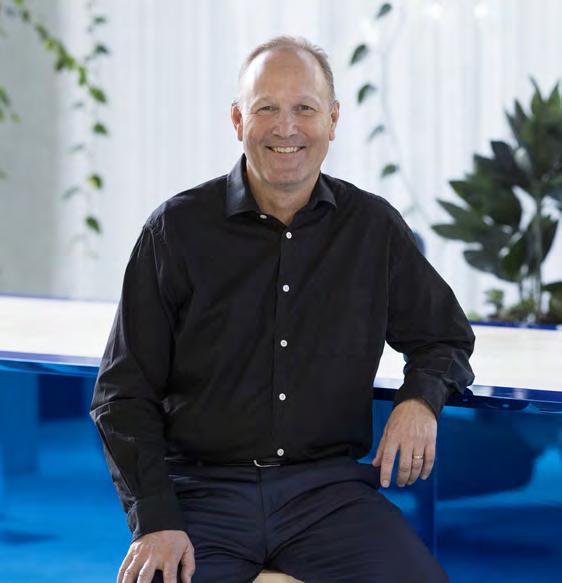
more likely than small businesses to have adapted their working model, and the research showed that decision paying off in better business outcomes. Businesses who had changed their working model were much more likely to say that productivity (38%) and their ability to innovate (50%) has increased since the pandemic than businesses who had not changed.
“We often talk about flexible work as a way to support our people, but these numbers show that it’s also a good business deci-
sion, and we’ve seen that ourselves at 2degrees,” says Andrew.
“This research goes to show that businesses of all sizes looking to improve their productivity and innovation should investigate new ways of working to unlock new opportunities, even in a difficult environment.”
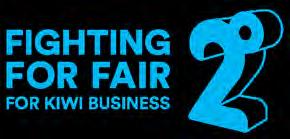
Andrew Fairgray,Chief Business Officer,2degrees
Mitch Handcock, Lexus ofTauranga
All-new Lexus RX
Passing the Crown
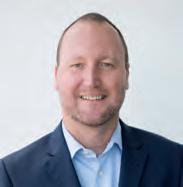
FRANCHISING
> BY NATHAN BONNEY
Nathan Bonney is a director of Iridium Partners. He can be reached at nathan@iridium.net.nz or 0275-393-022

The recent passing of HRM Queen Elizabeth II and Operation London Bridge exhibited perhaps the greatest example of a well planned and executed franchise succession plan ever. But of course, no individual franchisee or franchise system will have similar resources, nor perhaps the time to dedicate to succession planning. However, every franchise business owner from the day they open their business needs to consider what will happen and plan towards the day they need to pass their crown and business on.
Every plan starts with a list. There are a number of points that need to be covered on both the “To Do” and “Not to Do” checklist for a Franchisee Succession Plan. These apply equally as to whether the succession plan is one of internal succession from a business owner to the next generation or an internal heir, or via the sale of the business.
The To Do list
• Stick to the model and system –The more the individual business reflects the brand under which they are operating, the easier it will be for both an incoming management team and individual to operate. Additionally, the higher the quasi-value for the business will be as a “good example” of the brand.
• Keep good records – It goes without saying that if the succession plan is to sell the franchise, it will need good accounting and financial records. Good record keeping: data management, extends into all areas of the business including internal processes, customer records, training … the list is long. In all areas it will add value to the business and or ensure it continues to operate smoothly.
• Develop your team – Few franchise businesses are built around a single individual. Good business owners develop their team and ultimately work towards displacing themselves from the business.
• Keep the franchise up to date
– Which can range from ensuring marketing is current to, for bricks and mortar businesses,
being up to date with maintenance and refurbishment requirements. It can also extend into product ranging and associated stock management, processes, and software platforms; The less work that needs to be done by a successor or new owner to bring the business up to currency, the better.
The Not To Do list
There are two key areas for franchisees that will really disrupt or derail a smooth transition or succession planning.
• Diverting from the system –The further a franchise business moves from being an ideal example of the brand they carry, the greater the work involved to bring it back, and the greater the questions around value.
• Expiry – In my view perhaps the greatest failure for succession is allowing agreements or contracts to lapse, whether it be leases, supply contracts or the franchise agreement itself. There is inherent value in these key components of the franchise business which are critical for business continuity.
Don’t leave it too late
Operation London Bridge was 60 years in the planning and refinement, started when HRM Queen Elizabeth II was barely 40 years of age. It does demonstrate that it’s never too early to start to plan. And most importantly, don’t fail to plan for succession and miss the opportunity to take advantage of the benefits of developing and growing your own business.
When ‘theft’ is not a crime
According to the Crimes Act 1961 ‘theft’, or ‘stealing’, is the act of, “dishonesty and without claim of right, taking any property with intent to deprive any owner permanently of that property or of any interest in that property.“
It is a crime, whether it be a lollipop or a Ferrari, if you take it and haven’t bought it. It’s a crime. Right? … well, not always.
We had a client come to us a few years ago who owned a car dealership in the Waikato. He had sold a $10,000 car on a time-payment plan; He had the customer sign a direct debt form, provide ID, and then sign a contract. No payment was made at any time – in fact the account used to set up the Direct Debit was closed the day after the car deal was done.
The client reported the car as stolen to the police. While taking the report the officer asked, “So did he break into the yard or steal the keys?”
Our client replied, “No, I gave him the keys.”
The officer asked, “Did he threaten or intimidate you to give him the keys?“
“No, he was a lovely guy to deal with,” was the reply.
The officer then went on to say that the customer had not stolen the car, he had simply failed to pay for it – the officer suggested getting a debt collection company onto it or lodging a claim with the Disputes Tribunal.
According to a very elderly chap I met, the local constable used to go around and give a stern word to anyone with a habit of running up overdue accounts. Alas, that is no longer the case with the police force stretched in every direction
UNIVERSITY OF WAIKATO LAUNCHES FULL LAW DEGREE IN TAURANGA
Te Piringa Faculty of law is delighted to announce the full suite of Law qualifications at the University of Waikato will be available at the Tauranga campus from 2023.
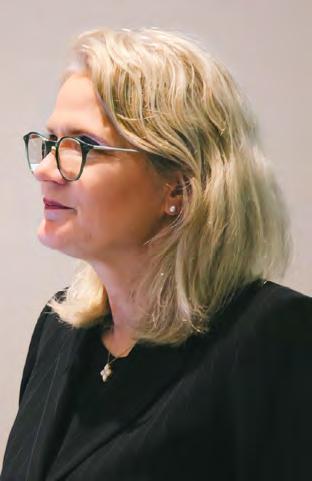
The faculty has been running its Diploma in Law programme in Tauranga for many years, serving many local Legal Executives in pursuing further legal education and transitioning to being a lawyer.

CREDIT CONTROL
> BY NICK KERR
Nick Kerr is regional manager for DebtFree NZ Ltd and director of International Private Investigations Ltd. He can be reached on 021 876 527 and Nick@debtfreenz.com

just dealing with serious and violent crime.
You see, a less-cunning average thief will smash through shop doors and pilfer items, clearly committing a premeditated act with a proven lack of intention to pay for the items – hence the ‘smashing in at night-time’, not the ‘walking in during opening hours’.
If they are caught, they may receive two years in a very uncomfortable motel. Or if it’s their first offence, maybe a slap on the wrist with a moist bus ticket. However, your more sophisticated ‘alleged intentional non-payer’ will understand how to achieve the same goal with very different consequences should they get caught.
Many will say that if someone orders something, finances some-
thing, or borrows money with no intention of ever paying, that is committing fraud. But this requires proving one sometimes very hard to prove thing: intent.
Occasionally we get lucky when investigating fraud when employees have been involved with an outside co-conspirator and we find an email or text message between them that proves intent to defraud.
But often the ‘alleged intentional non-payer’ will have cover stories that can make the non-payment seem like a bout of unfortunate luck. This then puts it into the realm of a defaulting payer situation, not criminal fraud.
I have seen these, in my opinion, ‘scams’, run on businesses for vast sums of money. They exploit
weaknesses in the credit management systems and lack of verification data for ascertaining who is a real customer, client or borrower and who is just a very clever thief.
The systems designed to protect the owners of genuinely distressed or collapsed businesses, such as trusts, limited liability, debt holidays, ‘no asset’ procedures, The Crimes act 1961 and The Privacy Act 2020 can unfortunately protect those who wish to misuse them to cover up dastardly deeds.
There are tools to help with detecting and deterring this kind of behaviour but having a good customer onboarding system and training is essential.
Remember credit is a privilege, not a right.
Just a thought.
From next year, it will be possible for students to study everything from the full LLB programme through to a PhD in Law at the Tauranga campus.
The announcement was made last week at the central city campus, followed by a sold-out public lecture by Chief Justice Helen Winkelmann on the topic of access to justice.
Dame Winkelmann’s address was the second annual law lecture in conjunction with Mackenzie Elvin law, which aims to bring the community and the profession together.
In her address, Dame Winkelmann identified two key strands of access to justice – access to knowledge of the law (people knowing their rights and entitlements), and access to the courts and tribunals where people can enforce those rights – and the imperative to improve both. It was an issue the government as a whole needed to be alive to, she said.
“I believe access to justice is a concern with which all government agencies should engage. Most rights and obligations are sourced from statutes and accessed through government departments. There is a compelling case for making access to justice a structural focus for all government departments.”
University of Waikato Dean of Law, Professor Alpana Roy said the event was also a chance to celebrate the 30th anniversary of the faculty, celebrations for which were postponed by Covid last year.
“For three decades, our Faculty has been a leader in a number of areas of legal research, including Māori and Indigenous legal systems, environmental law, and technology & future law. We have led the way in embedding Tikanga Māori concepts into our curriculum, and we’re excited to now offer this full study pathway to the Bay of Plenty.”
Mackenzie Elvin Law Partner Marcus Wilkins said the firm was delighted with the success of the second lecture.
“We feel privileged to have been able to partner with and support the Law Faculty and the University as it has established itself in the City and in their primary role as critic and conscience of the nation.”
The Rt Hon Helen Winkelmann (GNZM) who gave an address at the annual Mackenzie Elvin lecture series last week following the launch of the full degree programme.
SEEKA TO INVEST IN KATIKATI SEASONAL WORKER DIGS
New Zealand produce company Seeka has announced that it will build new Recognised Seasonal Employer (RSE) accommodation housing 140 people in Katikati situated at Sharp Road, replacing the existing facility.
The purpose-built accommodation will significantly increase the number of people able to be accommodated in the area and includes two recreational lounges and modern amenities such as wifi.
Michael Franks, Seeka’s Chief Executive said, “Our RSEs are highly valued and have been a huge help during the labour shortage throughout the kiwifruit harvest and more recently our orchard operations.
“It is important that we are providing quality living arrangements for their time with us and this project will deliver them a comfortable home away from home.”
Franks explained that the upgrade has been planned since 2018 but was delayed due to uncertainty around the RSE programme.
Franks said these workers complement the 800 permanent staff and 4,500 seasonal workers the horticulture company needs each year.
Making an office fit-for-purpose
New ways of working have highlighted the need for office workplaces to be more flexible.
As the pandemic’s tail whips its way through our work psyche and habits, business owners are being challenged on what constitutes a viable, market-relevant workplace in the bid to retain staff and attract new recruits.
Bayleys’ national director office leasing and real estate advisory, Steve Rendall says after an extended period of flux and staff routinely working from home, business owners are now grappling with what today’s office should ultimately look and feel like.
“We’re seeing a distinct flight to quality with companies seeking better functioning spaces to help get staff back to the office to collaborate and build culture.
“Some decision makers are trying to better understand likely working trends in the longer term before making wholesale changes, while others are reducing their footprints or clipping on flex space where required.”
Jonas Brodie, director and head of client relations at workplace strategy, design and construct firm StudioDB, says before designing or refitting an office space, the questions to be asked of clients are: what are the overall project objectives, how would you define success and why have an office?
“It’s a progressive journey and we encourage our clients to be transparent and share their business strategy which gives us considerable insight into how they may look to transition into a new way of working or remain status quo.
“We need to have tools that measure efficiency and performance

because what can be measured, can be managed, so for a project to be successful, it is vital to come up with a data set that does this.
“We also delve into the roles of those within the office and ask what’s best for the individual, their team, and the business overall so we can take an unbiased balanced approach and understand how activities are best done across those pillars.”
Brodie believes sustainability is the next big thing for office workplaces to nail and says, “our industry needs to be making measurable progress on sustainability while making it less complex and more affordable for all.”
Tim Ray, commercial manager for Platform Consulting Group says every business it works with has a unique way of working in the hybrid environment and requires a purposeful space built around work flow and human connection.
“The office environment now needs to be measurably better than the home office and be a place to reconnect with people so we design spaces with a welcoming entrance
incorporating a high end hospitality experience for employees, and multiple collaboration points to make the commute worthwhile and to support the office day.”
Ray says new and remodel fitouts are investing in more flexible, multi-functional spaces with adaptable furniture and integrated technology.
“Think technology-enabled stand up/huddle spaces, digital whiteboard spaces for a visual connection in the open plan environment and smaller meeting rooms with better integration for video conferencing.
“Equally important are spaces to disconnect from tech’, with informal collaborative lounge space, and open areas in the office with casual seating arrangements encouraging a play-work-rest workplace.
“With a 70-80 percent occupancy rate, clients see that more space can be dedicated to a structure that’s best for a team approach rather than the individual.”
Scott Compton, who leads interior design for architects Warren & Mahoney says the firm’s broad and
connected team knows that every client group is a unique amalgam of many things.
“The key questions we ask clients now are essentially the same as they always were, but are perhaps more relevant today and revolve around presence, purpose, and innovation.
“Why will your people come to the office, what will the office need to do and provide for your people, and what is the unique aspiration for your workplace?”
Compton says individual productivity, collaboration, team culture, and wellbeing are all inextricably linked and businesses need as much of each of those as they can get.
“Collaboration is the pillar that’s still a work in progress, as virtual collaboration can be isolating for individuals and ideal hybrids do not yet exist.
“We urge each client to think carefully about the big, aspirational, unique idea for their office environment that will excite, inspire and engage their people.”
Source: www.bayleys.co.nz/ workplace/articles/insights


Trustpower Baypark springing into action
Spring has arrived and along with it an exciting range of national and international sporting events are heading to Trustpower Baypark this season. With a huge increase in interest and attendance numbers climbing now that the traffic light system has been dropped, don’t delay in purchasing your tickets to whatever takes your fancy.
Silver Ferns v Australian Diamonds – 16 October 2022
Will the Silver Ferns be able to retain the Constellation Cup?
Don’t miss your chance to see the Silver Ferns battle-it-out live against the Australian Diamonds for a shot at the Cup! Trustpower Baypark has been able to secure one of the games in the four game test series. The teams will first meet on 12 October in Auckland before backing up later in the week in Tauranga on 16 October. The trans-Tasman rivals will then meet twice in Australia, first in Melbourne on 19 October and then on the Gold Coast on 23 October to complete the series.
Baypark centre pass is at 7.30pm Sunday 16 October – get your tickets ASAP www.silverferns.co.nz
HoopNation “The Classic” – 21-24 October 2022
Now in its 11th year, HoopNation “The Classic” has grown to become New Zealand’s premier basketball event showcasing some of the nation’s top ‘baller’ talent. Held over 4 days during Labour Weekend, the electrifying atmosphere of HoopNation sets it apart from other tournaments and is the must attend event for all basketball enthusiasts. This world class event attracts clubs, academies and basketball fans from throughout the NZ, Australia, the Pacific and Asia. www.hoopnation.basketball/ tournaments/the-classic
Speedway – Bay Summer Starter – 22 October 2022
The long-awaited return of Speedway revs up with the Summer Starter Season Opener on 22 October. The
superstocks are eager to get out on the track so join us for a huge night of racing action this Labour Weekend.
Be sure to mark 5 November on your calendar as the date for the ever-popular Fireworks night! Tickets to all 14 race fixtures for the 2022/2023 season will be available at the gate and via the website. The family zone is back, so there is something for everyone – get excited! Gates open 5pm with racing from 6pm. www.bayparkspeedway.co.nz
The Tauranga Home Show – 28-30 October 2022
From builders, beds and barbecues to flooring, fencing and finance, the Tauranga Home Show has 200+ exhibitors in one handy location.
While you have the chance to meet with hundreds of suppliers face to face, the kids are kept happy with fun activities such as face painting, bouncy castles and balloon twisting at no extra charge, not to mention food trucks outside. In the Live Cooking Kitchen we are excited to welcome Jo Seagar who will be demonstrating some of her latest recipes each day. www.taurangahomeshow.co.nz
New Zealand Festival of Squash 2022 – 3-13 November 2022
For the first time at Trustpower Baypark our Lion Foundation Centre will be transformed into a world class Squash facility with the all-glass court taking centre-stage as part of New Zealand’s largest ever squash festival.
The festival launches with the Nations Cup (3-6 November) – the testing ground for a major initiative with the inaugural Squash FORWARD series. A sequence of new
squash events intended to trial innovative changes to the way the sport is delivered. The Nations Cup will comprise eight teams of two players – one male and one female – from the same country to add a new dimension to the typical competition structure in squash and will include an alternative scoring format.
Following the Cup is the NZ Open (8-13 November). The biggest squash tournament on the NZ Squash calendar is back! After almost 30 years since the last NZ Men’s Open, and 13 years since the Women’s Championship, this will no doubt be an exciting week of fast paced competition! Our very own Paul Coll and Joelle King are set to be the star attractions amongst a top-class field of internationally ranked players. Players will battle for the lion’s share of a US$150,000 prize fund.
www.iticket.co.nz/events/2022/ nov/festival-of-squash
Woof Fest– 12 November 2022
The ultimate day out for you and your beloved doggo! Aotearoa’s first “hooman” and doggo festival is coming to Trustpower Baypark on the 12th November.
A fun day out for the whole family with a dedicated kid’s zone and plenty of doggos to pat, WOOF FEST is perfect for both dog lovers and owners. Live music, an epic adventure park for the dogs to go wild in, and vendors with dog and hooman food to cater for all! Grab your tickets before it’s too late www.wooffest.co.nz
Go Green Expo – 19 & 20 November 2022
NZ’s largest Green Living and Sustainable Lifestyle Show is coming to


Trustpower Baypark for the first time, and we are so excited.
Transform your way of life in favour of the environment (and you) by exploring the large diverse range of stalls: Eco home and building, food and beverages, organic products, health and wellness, beauty and personal care plus many more categories. This show is dedicated to promoting a healthy, environmentally friendly, sustainable lifestyle for New Zealanders. www.gogreenexpo.co.nz/ tickets
Weightlifting – NZ Masters & NZ Junior/Senior Championships –25 & 26 November 2022
Trustpower Baypark were lucky enough to host the Weightlifting National Championships in 2020 and we are delighted to welcome this event back for 2022. Featuring both the New Zealand Masters Champs starting on Friday and Junior & Senior Champs to follow, it is bound to be a high energy few days showcasing the strength of the country’s top weightlifting talent. www.weightlifting.nz
Polo in the Bay – 26 November 2022
Start your summer the right way by gathering your friends for Polo in the Bay. A whole new tradition and building on the first Polo event in Jan-

uary, the event is set to be a fixture on your annual social calendar.
The fresh, fast-paced format is designed for spectators and requires ZERO polo knowledge to enjoy. With hospitality options to suit all, not to mention epic food trucks, lawn games and plenty of entertainment between chukkas, this special day in the sun will be hard to resist.
Get your crew and your tickets locked in soon www.polointhebay. co.nz/tickets
Stadium Corporate Boxes
Enjoy Stadium events in comfort from a corporate Box. There are still a number of excellent boxes available for either an annual lease or casual bookings for the summer season. Quality hospitality is served to your box with an exclusive balcony and relaxed environment to entertain your guests.
For more information events@ bayvenues.co.nz
Tauranga’s Premier Venue
Trustpower Baypark is Tauranga’s Premier Venue for conferences, meetings, entertainment, and exhibitions. Offering a complete package in one convenient location that features state of the art meeting rooms, in-house catering, audio visual services, marketing/promotional services.
International tourists set to bring windfall for BOP property owners
The arrival of international visitors will see the cost of renting a holiday home reach record levels this summer, according to new data.
Latest figures from Bachcare, New Zealand’s largest holiday home management firm, show forward bookings from overseas tourists, strong domestic demand and a shortage of rental accommodation are driving a 25% increase in peak pricing.
Demand is forecast to be strongest in the Coromandel, Queenstown and Bay of Plenty for large waterfront properties offering a spa and WiFi, with local holiday homeowners set to see a significant increase in rental income in the coming months.
The data shows the top 50 holiday homes around the country earn an average of $65,000 rental revenue, with the highest earner recording $81,000 per annum.
Nick Peirce, Bachcare head of revenue, says the company has sold 31% more nights for the coming summer season than the same time last year.
He says international visitors are on track to extend the summer peak period into February, while the domestic market tends to tail off after Waitangi Day.
“Compared to the 2021/22 summer period, we have already sold around 3,100 more nights – with December up by around 52%.
“The data shows international visitors make up 15% of all summer bookings, which is similar to the pre-pandemic levels and up significantly on the negligible volumes of bookings from overseas we saw last year.
“While the 2021 season set new
booking records for us, the arrival of overseas tourists could see February grow by a further 10% this year, which equates to a significant increase in income for bach owners.
“At the same time, there is a continuing strong demand from Kiwis wanting to holiday locally, which is expected to create a shortage of accommodation stock during the coming peak season,” he says.
Peirce says holiday homeowners in some regions will be able to earn up to $1,500 per night during the peak by renting their property out.
He says a property which would normally sell for $1,000 per night during the peak is now selling at $1,250.
“Pricing in this part of the tourism industry is closely tied to the availability of supply and when there is a shortage, it creates an opportunity for property owners to earn up to $81,000 per annum – with around fifth of this revenue earned in January alone.
“Our analysis shows that the ideal property is lakefront or beachfront, in close proximity to a population hub, is a larger home which caters for families or groups of friends, and has good outdoor entertaining areas and WiFi.
“Properties with a spa will earn 43% more than those without and a bach with five to six rooms will earn almost twice as much as one with three to four rooms,” he says.
Peirce says the top five earning holiday homes across the more than 2,300 homes they represent are in Mt
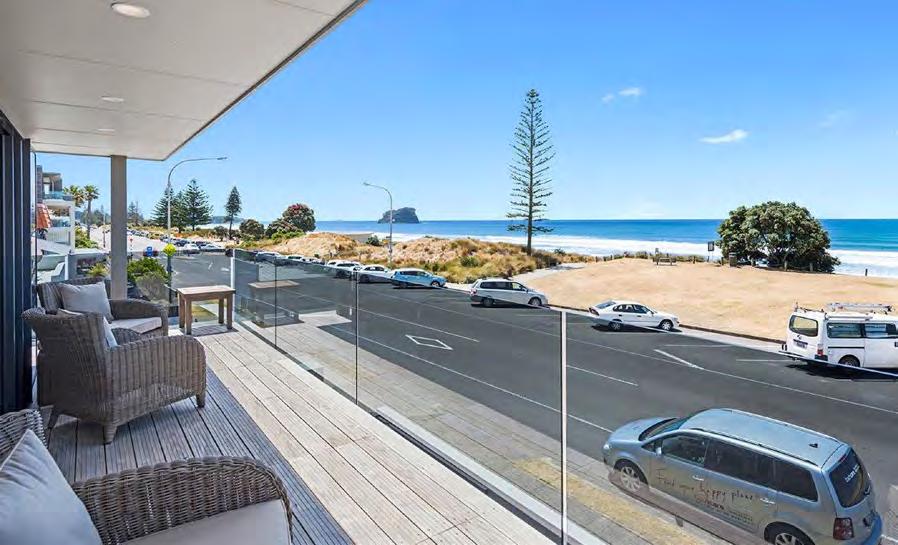
Mount Maunganui has the country’s top-earning holiday rental property. Photo/Supplied.
He says for non-ski areas, 40% of total earnings are generated between December to February.
“What we can see from the latest regional data is Southern Lakes has the highest average gross rental income per property YTD at $21,324, however the top 20 properties in this region earned on average over $61,000 YTD.
“On average, a holiday home in the Coromandel will earn $13,577, with the top 20 earning on average $49,800 YTD. The highest average earning areas in that region are Whangapoua, Hot Water Beach and Kuaotunu.
“In Bay of Plenty, properties in Mt Maunganui will see an average $21,300 annual rental with the top 20 earning on average $37,600 YTD. The Mount also has the country’s top earning property,” he says.
Peirce says they are encouraging holiday homeowners to consider listing their property while it is not in use and are advising domestic travellers to make bookings as early as possible to reduce the cost of their stay.
David Aitkenhead, the owner of one of Bachcare’s most frequently booked holiday homes, says they initially purchased a holiday home to be close to family, however renting it out while they were not using it has provided a number of financial benefits.
He says hotel accommodation in his area is often at capacity and providing their property at peak times helps ease the pressure on existing infrastructure for tourists.
“Our experience with the shortterm rental model has been positive. Bachcare manages the property proactively and uses a revenue optimisation algorithm to adjust the rates in response to occupancy in the area.
“Our advice to others considering the model has been to work with a company that offers local support, so that the property manager can develop a familiarity with your property. If there are any issues, they can visit and resolve them with minimal disruption to guests,” he says.
MASSIVE FUNDING BOOST FOR RESEARCH
From incorporating mātauranga Māori into marine restoration to Xeno Nucleic Acids that could have impacts on cancer research and rock weathering for carbon capture, University of Waikato projects funded in the latest round of MBIE research grants have the potential to change the world.
More than $26M has been awarded to Waikato researchers and their teams from the 2022 Endeavour Fund supporting both Smart Ideas and Research Programmes. Deputy Vice-Chancellor, Research, Professor Bryony James says the funding is a testament to the quality of Waikato research.
“Recognition like this is a tangible acknowledgement of the impact and value of the work our academics and researchers do. This work has such practical implications and couldn’t be done without the support of the wider university and, of course, our collaborative partners around Aotearoa and the world.
“I am incredibly proud of what this says about the University of Waikato and the contribution these projects will make to our people, our places and our future.”
Pou Rāhui, pou tikanga, pou oranga: reigniting the mauri of Tīkapa Moana and Te Moananui-ā-Toi ($13M)
Lead Investigator Professor Kura Paul-Burke will co-develop pragmatic restoration actions for identified marine taonga species within rāhui areas of five iwi (Ngāti Pāoa, Ngāti Tamaterā, Ngāi Tai ki Tāmaki, Ngāti Hei and Ngāti Rehua Ngāti Wai). The project will collaborate with
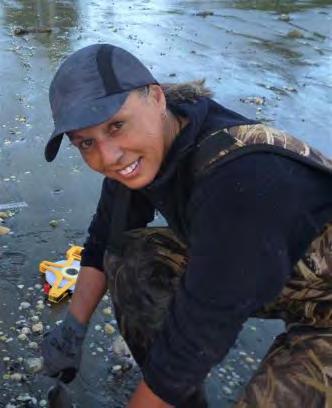
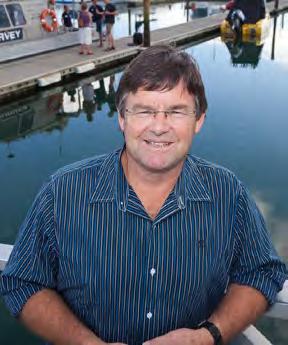
iwi to investigate and share
mātauranga Māori approach, supporting a deeper
understanding of rāhui and existing mātauranga in a contemporary context alongside modern scientific tools.
It also aims to develop capability within the iwi for assessing the need for and implementing and managing rāhui, creating a space for new iwiled, mātauranga and science-based decision-making and management/ restoration of coastal ecosystems.
Toka ākau toitu Kaitiakitanga – building a sustainable future for coastal reef ecosystems ($8.8M)
Professor Chris Battershill is the Lead Investigator on this project, which will incorporate mātauranga Māori in work to improve the health of the coastal environment and contribute to reversing the decline of New Zealand’s kelp ecosystems.
Using test kelp forest beds in four economically, ecologically and culturally important regions, the project will work across three themes to establish pathways into co-management models, test and model variables between and within regions, and assess and evaluate interventions.
The impact will be seen in more resilient rocky reef ecosystems, and the development of sustainable intergenerational management strategies for kaimoana and marine health.
SMART IDEAS
Enhanced rock weathering for large-scale capture of carbon dioxide in Aotearoa
Dr Terry Isson is investigating the potential for accelerating rock weathering in permanent pasture, with the goal of increasing carbon capture rates and contributing to carbon neutrality in farming.
Spatially mapping galaxiid nests with scent detection dogs and unmanned aerial vehicles
Dr Nicholas Ling will use scent detection dogs and drones to gather data on whitebait spawning areas for the benefit of environmental and fishery management planning.
A ligase-based solution for non-natural nucleic acid synthesis
Dr Adele Williamson is developing a platform for synthesising artificial versions of natural DNA and RNA, or XNAs, which hold the potential to advance biosensing, diagnostics and therapeutics.
Lightweight compliant mechanism robotic grippers for fruit harvesting
Dr Ajit Pal Singh is developing a new generation of fruit harvesting robotic grippers in support of increasing the commercialisation potential of high-value agritech tools from New Zealand.
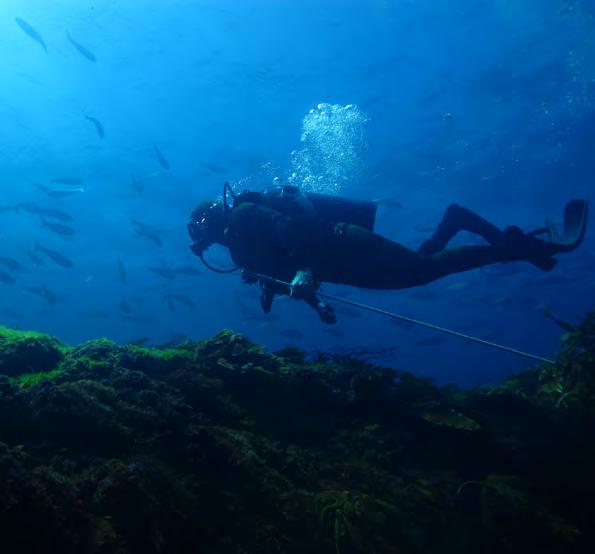
Maunganui, Paihia, Queenstown and Te Anau.
localised knowledge based on a
Professor Kura Paul-Burke
Professor Chris Battershill
NEW APPOINTMENTS
BBN’S GUIDE TO NEW PEOPLE AND NEW ROLES ACROSS BUSINESS IN THE BAY
To feature in New Appointments email us at new.appointments@bopbusinessnews.co.nz
Jenna Waite-Leonard
Jenna Waite-Leonard has been appointed to the position of Head of Communications for Whare PR and Village PR communication agencies. In the newly created role, Jenna will lead and build the team of communication and creative consultants and help drive the rapidly growing client base. The senior appointment is part of the agency’s expansion due to the increased demand for its public relations, cultural advisory, creative, digital and experimental services.

Waite-Leonard joins from Toi Ohomai and Te Kuratini o Waikato (Wintec), where she spent close to four years overseeing the communication and digital functions and teams of the two large institutes. Spanning her 15-year career in the industry, Waite-Leonard has held senior roles across various agency, corporate, and notfor-profits sectors in Australia and Aotearoa.
Peter Marr
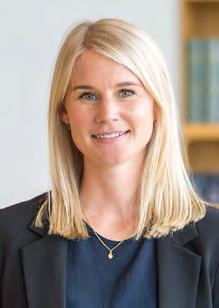
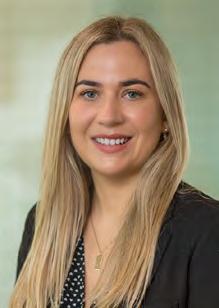
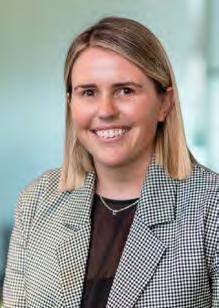


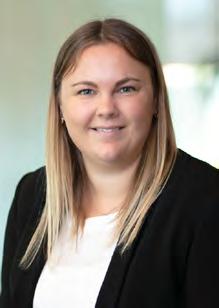
CHANGES APLENTY AT HOLLAND BECKETT LAW
Anna Needham – Associate, Civil Litigation & Dispute Resolution
Anna holds an LLB (First Class Honours) and BSC from Canterbury University. She started her career in leading South Island firms where she was quickly promoted to senior positions. She moved to Holland Beckett Law in November 2020. Since joining Holland Beckett Law, Anna has been involved in some of the firms most complex litigation cases. She has appeared in several High Court trials and has assisted with commerce commission and cross-border cases, as well as being involved with some of the firms biggest trust and estate disputes. Anna is a board member of Q-Awards Charitable Trust and is a successful triathlete. Her background in sport is something she also carries into her work, providing assistance to athletes and clubs in sports related disputes.
challenging employment matters including restructuring and complex cases that arose out of Covid-19. She has also acted for some of the firms leading clients. Stephanie has also been a board member of Merivale Community Incorporated for over a year, helping them navigate through recent changes.
Sophie
Law – Associate, Employment & Relationship Property
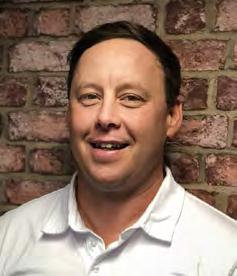
Dunes Consulting is pleased to announce the appointment of Peter Marr to its team. Dunes Consulting recruit jobs in the construction, engineering and architecture space across Tauranga, Hamilton and the wider Bay of Plenty and Waikato regions. Pete has been in the construction game for over seven years, where he ran and managed a sub-contracting business, working across the residential and commercial sectors. Now recruiting across the commercial, civil and residential space, Pete will be able to guide and help you find the most appropriate job to suit your needs.
Stephanie Berkahn – Associate, Employment
Stephanie holds an LLB and BA from Waikato University. Previously she worked at a specialist boutique employment law firm in Auckland and in the employment teams at two Magic Circle law firms in London. Stephanie returned to New Zealand to join Holland Beckett Law’s employment team in July 2021.Stephanie has been involved with some of the firms most
Sophie holds an LLB from Waikato University. A Tauranga local, she started her career at a Magic Circle firm in London before returning home to Tauranga. Sophie joined Holland Beckett’s employment and family law team in 2018. Sophie has a track-record of great client outcomes. Recent successes have seen her resolving substantial relationship property and employment matters. Sophie reflects Holland Beckett Law’s commitment to the Tauranga community with ongoing pro-bono assistance, which has included judiciary matters for rugby clubs and operating a legal clinic at Tautoko Mai for women who have been the victims of sexual assault.
Brittany Ivil
– Associate, Property & Commercial
Brittany holds an LLB (First Class Honours) from the University of Waikato and joined
Holland Beckett Law in 2016 to practice law where she grew up. Brittany is in the Property Team and specialises in all matters relating to private trusts and charitable organisations. She undertakes work with experience, skill and judgment which is appreciated by her clients. Brittany has always demonstrated a willingness to give back to the community and this has resulted in her becoming a shadow board member of the Tauranga Arts Festival Trust. She is a team player who assists staff with professional growth and regularly contributes to the firm’s systems and processes.
Laura Murphy – Associate, Environment & Resource Management
Laura holds an LLB (Hons) and a BA from Victoria University. Laura joined us in 2020 after returning from London in between global waves of Covid. She quickly became a trusted pair of hands in the Environment and Resource Management space where she has delivered legal services for Holland Beckett Law’s key corporate clients and land developers. One of her more notable cases saw Laura spend seven weeks in a High Court hearing on a customary marine title claim. Laura makes a valuable contribution on the committee of the Resource Management Law Association for the Bay of Plenty, is a Board member of Priority One and is a Project K mentor through the Graeme Dingle Foundation.
Tauranga teaching student wins adult learner award
Covid-19 gave Jasmine Campbell (Ngāpuhi) the push she needed to change careers and enrol at university. The transition from tourism industry to teaching has earned her a Vice-Chancellor’s Adult Learner’s Award and a cash prize.
Jasmine, 30, had been working in the tourism industry on Australia’s Gold Coast when the pandemic began, and when visitor numbers declined she decided to move back home for a new start. She is currently in her second year of her Bachelor of Teaching (Primary) degree at the University of Waikato’s Tauranga campus.
Her decision paid off when she was recently awarded the 2022 Vice-Chancellor’s Adult Learners’ Awards – one of four given out by the University at a ceremony at the Tauranga CBD campus. The awards recognise the academic achievements and social contributions of outstanding adult learners at the University of Waikato who have chosen to undertake tertiary study later in life.
Recipients have to be at least 25 years old, in their second year of partor full-time study at the University and be studying towards an undergraduate qualification. The awards were presented at an in-person ceremony by Vice-Chancellor Neil Quigley, and each recipient was also given a cash prize of $1000.
“I was so happy and excited when I found out [about the award],” says Jasmine, who was nominated by one of her lecturers.
“I didn’t even know how to write an essay when I first started. It is so nice to be recognised for all the hard work I’ve been putting in. It will also take the financial pressure off as I can’t work full-time while studying.”
The former Mount Maunganui College student had travelled to Australia after high school for a gap year, but “one year turned into 10,” she says, with stints working at Dreamworld, Whitewater World and SkyPoint Climb.
Jasmine admits that she “had no idea what she wanted to do, or if I
wanted to go to University,” as a high school student, and returning to study in her late 20s was “a bit scary” at first.
“But I talked to my Nana, who went back to university in her 60s, and she told me that if she could do it, then so could I.”
She chose the University of Waikato because the Tauranga campus is close to home, and the University had a good reputation.
Jasmine enrolled in the University’s Tauranga Jump Start programme in January 2021 to help prepare her for tertiary study. The support from lecturers and her experiences as a teaching student on practicum in local classrooms have also been positive.
“Seeing the children grow and develop new skills in the classroom each week was quite rewarding.”
A testament to her academic achievements, Jasmine was recently inducted into the Golden Key International Honour Society. She also works as a student ambassador and has volunteered at Tauranga Open Day and Virtual Open Day.
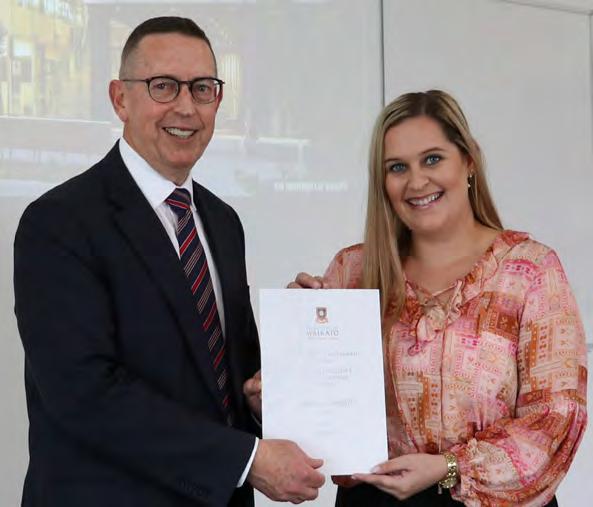
“I’ve always loved working with kids,” says
when
In the future, Jasmine hopes to work as a primary school teacher in the Tauranga area, and perhaps do a master’s degree in Education.
Jasmine. “Even
I was working in tourism, teaching kids
to surf, I loved seeing them learn.”
Three of the four award recipients – Rebecka Billington, Jo Mariu and Jasmine – are University of Waikato Tauranga students. Jared Kelsen from the University’s Hamilton campus also received the award.
Anna NeedhamStephanie BerkahnSophie Law Brittany Ivil
Laura Murphy
Jasmine Campbell andVice Chancellor Neil Quigley
RESEARCH SET TO BEGIN INTO GREAT WHITE SHARKS IN BAY OF PLENTY
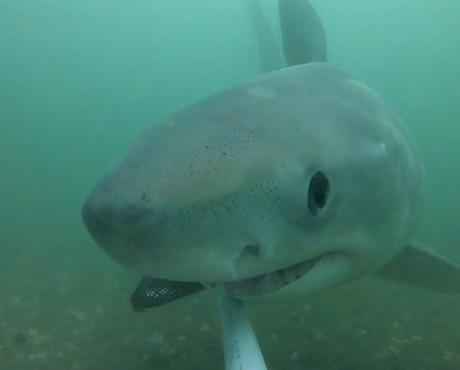
A new project bringing together local iwi, marine ecologists, fisheries scientists and shark experts will research Great White Sharks in the Tauranga Harbour and wider Bay of Plenty this summer.
The collaboration comes after a notable increase in the frequency of interactions between humans and Great White Sharks in the area over the last few years. With each new interaction, fear and anxiety has appeared to increase and there have been calls for something to be done to better understand the situation and manage the risks to humans entering the ocean.
Project lead and University of Waikato marine ecologist Phil Ross says the research team is currently working with hāpu from the northern harbour, Te Whanau a Tauwhao and Ngati Te Wai, to refine plans for the summer’s research activities and to develop longer term goals for the research.
“We plan to have the research up and running before summer arrives so we can begin the process of learning about the size and make-up of the white shark population in the Bay, and gaining a better understanding of the behaviours and movements of individual sharks in the area.
“We’re also working to create opportunities for the public and citizen scientists to be involved in this important work. We know there have been a lot of encounters between White Sharks and spearfishers, surfers and swimmers. We want to capture that information and use it to better understand these awesome creatures.”
The research aims to understand the observed changes in White Shark abundance and behaviour and inform any future White Shark management in the Bay of Plenty.
Reon Tuanau, from Otawhiwhi marae says he is grateful to be part of a project that will combine science with Māori tikanga.
“We are very keen to learn more about the increased presence and activity of the Great White Shark in our moana. We have a long standing relationship with the team of experts that
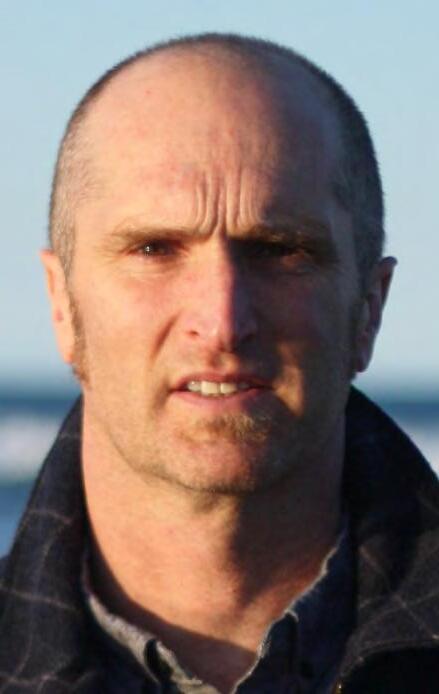
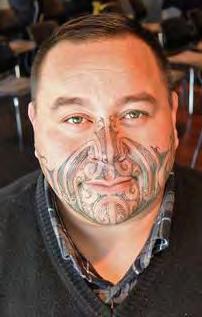
has been brought together to partner with our Hapū in gaining a greater understanding of the changes that are occurring in the moana.”
The project includes input from:
● Hapū (Te Whanau a Tauwhao and Ngati Te Wai) from the northern Tauranga Harbour (where most of the White Shark activity has been) represented by Reon Tuanau (Te Whānau a Tauwhao ki Otawhiwhi Marae Chairperson), ● Scientists/researchers from:
The University of Waikato (Phil Ross, Melissa Kellett, Chris Battershill) – Manaaki Te Awanui (Caine Taiapa) – Department of Conservation (Clinton Duffy) – Conservation International (Mark Erdmann) – NIWA (Darren Parsons) – New Zealand’s Great White Shark Research Project (Kina Scollay).
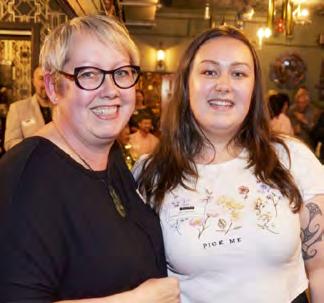
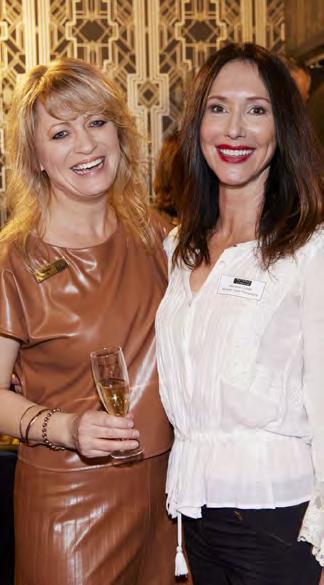
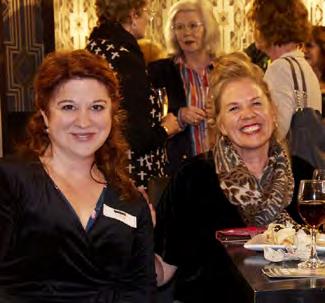
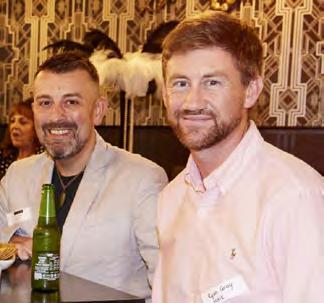
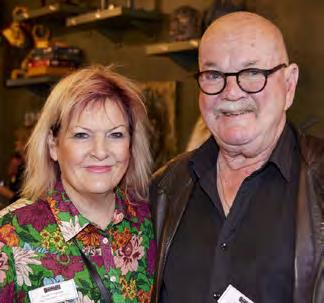
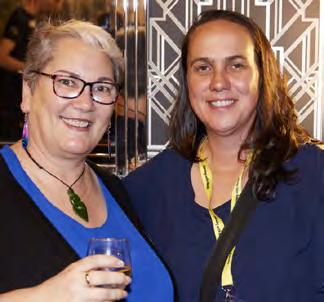
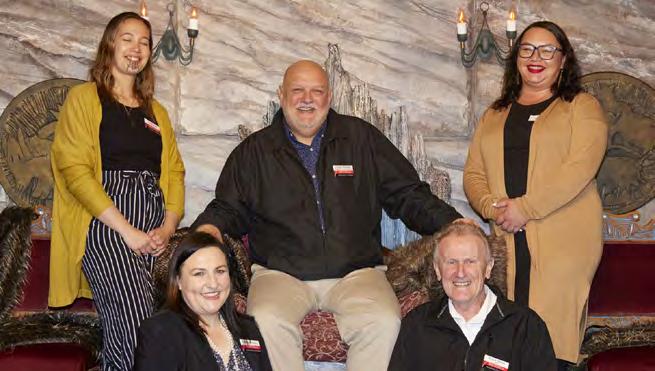
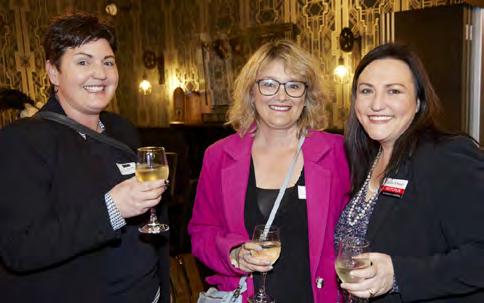
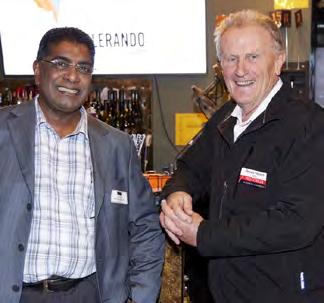
1 7 4 8 5 9 10 2 4 11 12 6 3
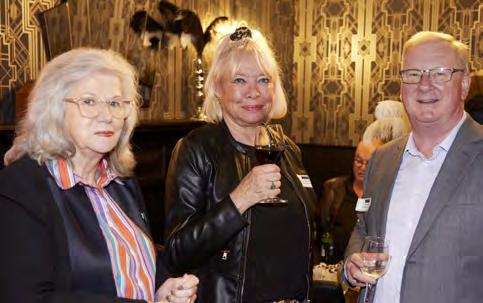
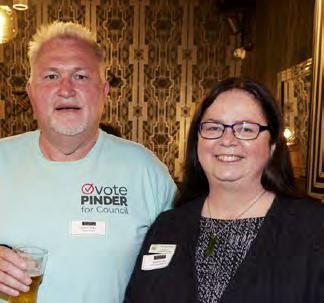
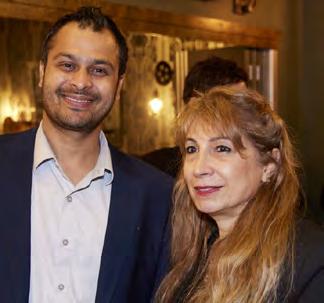
10 John Chetty (Red Chillies Holding Limited), Bryce Heard (Rotorua Business Chamber). 11 Steve Pinder, Desirae Kirby (Rotorua Sustainable Charter). 12 Yogi Bhati (Number 8 Wire Farm to Plate), Shaz Shafarzadegan (Dancing Scissors).
1 Liz Carrington (Youth Music Aotearoa Charitable Trust), Ellis Carrington (Youth Music Aotearoa Charitable Trust).
2 Jo Holmes (RotoruaNZ), Nadia Christensen (McDowell Real Estate) 3 Tim Smith, Ryan Gray (MBIE).
4 Anne Tregilgas (Sotheby’s Rotorua), Don McCarrison (Bay Decorators). 5 Carol Buckley (People Possibilities Limited), Viv Sutton (Life Education Trust Rotorua).
6 Angelique Scott (Personnel Resources), Michelle Cutelli (Michelle Cutelli Photography). 7 Tessa Hunt, Charlie Windell, Hine-Te-Rangi Elliott, Cecile Whelan, Bryce Heard (Rotorua Business Chamber Team).
8 Jules McLaughlin (Life Education Trust Rotorua), Sue Baty (Avid Business Agency), Cecile Whelan (Rotorua Business Chamber). 9 Marilyn Christian (Bill & Marilyn Christian), Lily Prummel (Lilies Cleaning Services), Jon Dimock (Ministry of Education).
Reon Tuanau
Phil Ross
Campus celebrates University graduation
There were cheers and tears when 222 people graduated at the University of Waikato’s Tauranga campus in early September, in the first in-person graduation ceremonies at the site since June 2021.
University Chancellor, Sir Anand Satyanand, congratulated students and thanked their families for supporting them with their studies.
“Today is a good time to reflect on the months and years you have spent studying, going to tutorials and now, at the end of it, you have realised the goal you were seeking,” he said.
He challenged graduates to “make the best of what you have learned at the University of Waikato”.
Leah Owen, who was receiving her Bachelor of Social Sciences degree majoring in Psychology at the 10am ceremony, says that it was a day to celebrate and reflect on “the strength and resilience” of reaching graduation day.
“To my fellow graduates – we did it. Despite everything the world threw at us, we are here today.”
Among the degrees conferred at Tauranga were 108 bachelor’s, five
bachelor’s with honours, 19 master’s, one PhD and 89 postgraduate or graduate diplomas.
Abigail Carrillo Fibela, 25, was one the 2019 cohort of inaugural students starting at the newly opened campus.
“We were pioneers,” says Abi, who graduated today with a Bachelor of Social Sciences degree majoring in Sociology and Political Sciences from the Tauranga campus. “It was good to start at this brandnew campus, and we were in small groups, so we made good friends.”
Abi is from Mexico originally, but moved to New Zealand six years ago. Since finishing her studies last year, Abi has started working for Toi Mai – Workforce Development Council in Wellington.
Fiona Taiena Patiunia Helu was wearing dozens of money and lolly lei gifted to her by friends and family to celebrate her graduation day.
Fiona, who is originally from Tonga,
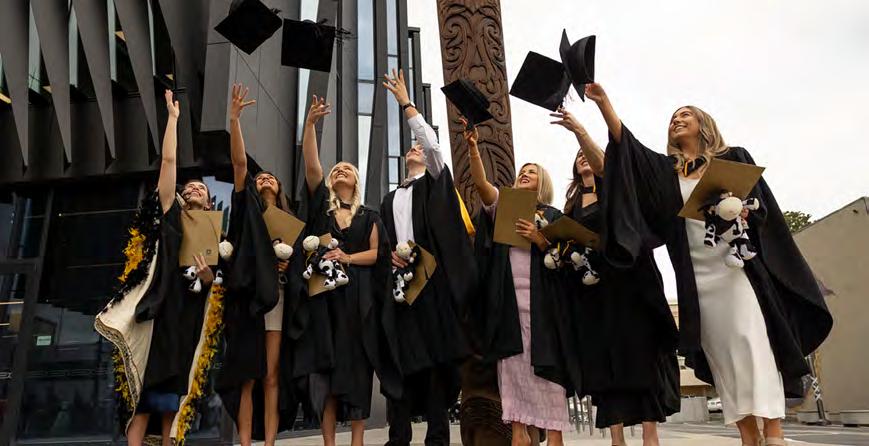
graduated with a Bachelor of Social Work, and is now working as a social worker at children’s charity Barnardos in Auckland.
“I wanted to do something to support families, young Pasifika and Māori kids growing up in the system, or from troubled homes.”
The support of her family, many who were at graduation, made a big difference to Fiona.
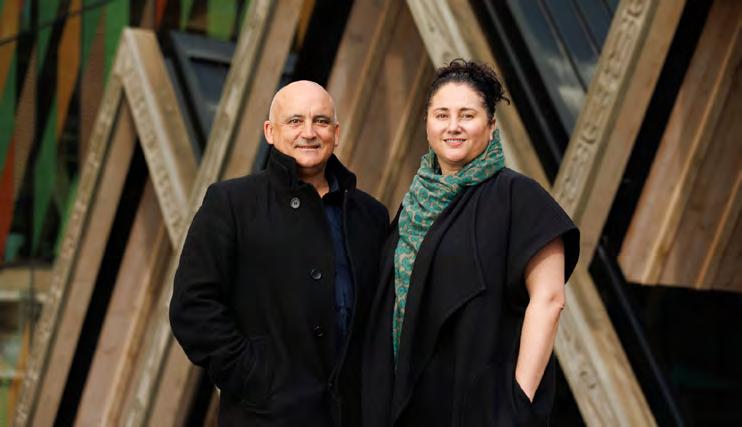
Cheniel Powell received her Master of Applied Psychology degree with first class honours, along with a Postgraduate Diploma in the Practice of Psychology in Applied Behavioural Analysis.
The Tauranga mother of three says it felt “amazing” to receive her qualifications in front of her family.
“It’s been a long time coming,
and it’s a relief. I have had so much support along the way from my husband Michael, from my in-laws, and of course my kids,” said Cheniel.
The Tauranga ceremonies were the first in a week of University of Waikato graduation events in Tauranga and Hamilton.
There were eight ceremonies in total, with 1666 people graduating overall.
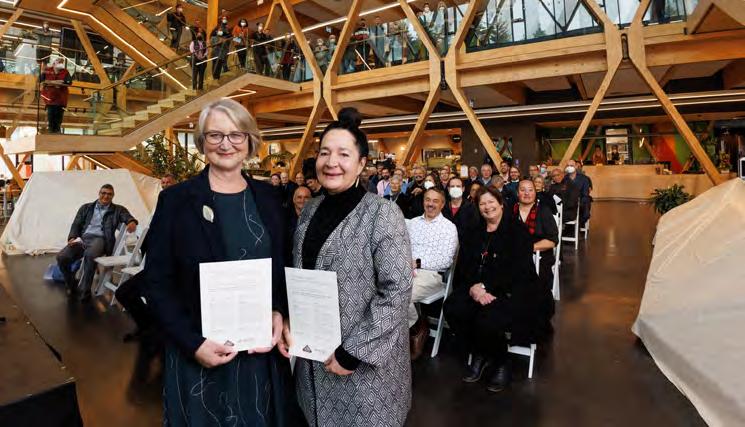
Scion and Nga Hapū e Toru sign
Kawenata
Veronica Butterworth, a trustee representing the three hapū –Ngāti Hurungaterangi, Ngāti Taeotu and Ngāti Te Kahu (Ngā Hapū e Toru) signed the Kawenata (Memorandum of Understanding) with Scionboard chair Dr Helen Anderson during a formal ceremony, surrounded by the hapū, Scion board, staff, and guests.
Ngā Hapū e Toru are tangata whenua of the 114-hectare site where Scion is situated in the Te Papa Tipu campus.
Butterworth says the signing for Ngā Hapū e Toru is a significant step forward in the partnership with Scion, which in turn is a step towards strengthening the mana of the land and hapū.
“The Kawenata acknowledges the genealogical connection through our whakapapa to this land. This land is part of our rohe, our turangawaewae, and is the basis of identity and wellbeing for our people.
“Working together with Scion to honour this Kawenata, we will work on mutually beneficial goals. The matapono (principles) of the Kawenata are whakapapa, kotahitanga, rangatiratanga, manaakitanga and tiakina
A new dawn for partnership has been hailed with the signing of a Kawenata / Memorandum of Understanding between tangata whenua and Scion at Te Whare Nui o Tuteata in Rotorua.
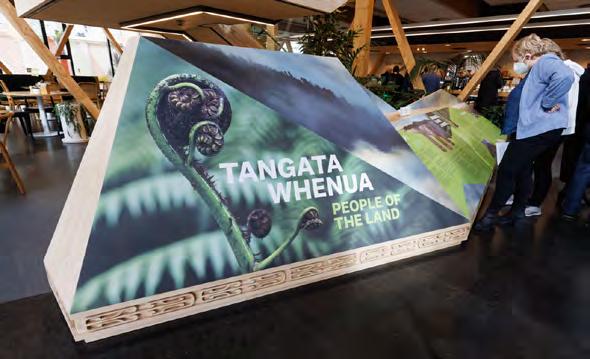
te mana o te whenua.”
Scion chair Dr Helen Anderson says the signing marks a significant milestone for the Crown Research Institute and its enduring relationship with tangata whenua.
“We are signalling how Scion and tangata whenua recognise the value of working together in the spirit of cooperation and partnership. We have common principles and an unwavering commitment to protect the waterways, forests and whenua.”
“As Scion takes bold new steps
with research to support New Zealand’s transition to a circular bioeconomy as part of efforts to meet climate change objectives, we are committing to a set of principles that will underpin our close relationship with tangata whenua and help us navigate the challenges and opportunities ahead.”
The signing was followed by the launch of a new permanent visitor display in the building’s atrium, sharing the history and connection that Ngā Hapū e Toru have to the whenua, while also explaining the significance
of forestry science and innovation to New Zealand and the world.
Co-funded by Scion and Te Uru Rākau, New Zealand Forest Service, the displays are a creative storytelling experience that share the history of tangata whenua, forestry, and the future.
One display describes Ngāti Hurungaterangi, Ngāti Taeotu and Ngāti Te Kahu. It explains the deep connection to the whenua, with historical pā, kāinga, cultivations and wāhi tapu (sacred sites), as well as looking to hapū aspirations – including partnership.
The other display documents the history of New Zealand’s forestry industry, starting in the late 19th century when the first exotic trees were planted in a nursery at the Whakarewarewa Forest. The storytelling dives deep on the value of radiata pine, along with the importance of forests to New Zealand for timber production, biodiversity, biomaterials, tourism and to tackle climate change problems the world faces.
Scion chief executive Dr Julian Elder says the signing and launch of the visitor display recognises the important role that tangata whenua
will play in the future of Scion as a Crown Research Institute.
In the spirit of partnership, Scion looks forward to future engagement with Ngāti Hurungaterangi, Ngāti Taeotu and Ngāti Te Kahu as tangata whenua.
Butterworth says that, “Explaining our connections to the whenua, as documented in the atrium display, is a wonderful way to welcome manuhiri (visitors) to Te Whare Nui o Tuteata. This building is named for Tuteata, who is the ancestor of all three hapū.” Earlier in the morning, a whakatau (welcome) was held for new board director Brendan Green (Ngāti Hikairo, Ngāpuhi) and new future director Dr Melinda Webber (Ngāti Whakaue, Ngāpuhi, Ngāti Kahu).
The ceremony came two months after Ngā Hapū e Toru led the unveiling of four pou whenua on Tītokorangi Drive, as part of a partnership with CNI Iwi Holdings Ltd, Rotorua Lakes Council, and Kānoa – Regional Economic Development and Investment Unit.
The pou, part of the Whakarewarewa Forest Development Project, share the history and connection of Ngā Hapū e Toru to the land.
Left: A whakatau (welcome) was held for new Scion board director Brendan Green (Ngāti Hikairo, Ngāpuhi) and new future director Dr Melinda Webber (Ngāti Whakaue, Ngāpuhi, Ngāti Kahu). Right: Scion board chair Dr Helen Anderson (left) and Veronica Butterworth (right), a trustee representing the three hapū – Ngāti Hurungaterangi, Ngāti Taeotu and Ngāti Te Kahu (Ngā Hapū e Toru) with the Kawenata (Memorandum of Understanding) that was signed in a formal ceremony surrounded by the hapū, Scion board, staff, and guests.
Changing world reflects changing generational expectations
If the teacher ever said, “I need to speak to you about your child”, I would immediately panic: “What has he done now?”
Something has changed. ‘Modern’ parents (of which I am obviously not one) now must choose between two default reactions – either Johnny has been bad, or, the teacher is a b***h.
There is no longer any middle ground – you must pick a side. Either, “Johnny can’t be to blame; That teacher always picks on him, he says so; B***h”, or, “If the teacher is taking the time to call me, there is an issue and I should listen.”
In much the same way that, despite the facts, many Americans believe the election was stolen, so, many parents believe, despite the facts, that the teacher is a b***h.
Sure, Johnny may have suggested the teacher was an idiot [actual words substituted] and said, “Get f****d”, but as mum notes, “Johnny wouldn’t say that unless the teacher is an [idiot – actual words substituted] and has provoked him.”
Lesson learned – not just by Johnny, but also by the teacher: Don‘t criticise Johnny!
My point is not that the teacher cannot be an ‘idiot’ – of course he or she may be – but rather the default position now is so often that the teacher is somehow the enemy.
As far as many mums and dads are concerned now, if Johnny says, “The teacher is picking on me,” then the

HAVE YOU EVER NOTICED?
> BY ALAN NEBEN
Alan Neben is a Mount Maunganui local and an experienced New Zealand publisher. He tries to never begin a sentence, “Kids nowdays ...” “Children must be taught how to think, not what to think.” – Margaret Mead
teacher is a ‘b***h’ – there is no ‘innocent until proven guilty’, no rite of reply afforded the teacher. The die is cast.
As an employer, I now regularly see such attitudes in the workplace.
Sure, there are teachers who will get it wrong, who may be socially inept, or who may simply be having a bad day – but in all other respects, are regular adults. So please, please, let’s give them, as trained, fully developed, professional adult humans, some benefit of doubt when called to account by often belligerent ‘not-fully-baked’ adolescents who often have a naturally rebellious teenage instinct to ‘stick it to the man’.
That’s not a put-down of adolescents, simply a balancing of the facts and an objective observation of developmental instincts at play.
Be clear, not for one moment will I ever defend bullying, rudeness, infliction of harm or lack of respect and decency by any adult to any other human of any age. And consistently poor behaviour by adults, be they teachers, doctors or bosses must be rooted out and dealt with.
But, if the teacher insists for example that students not be disruptive in class, and they not use smart phones and ear buds while in class, I will always back the teacher who physically removes the earbuds and admonishes offending students – no excuses. I will never condone the response of a student who then calls the teacher a ‘[deleted expletive]’ – such disproportionately offensive responses and aggressive, disruptive behaviours are never okay.
It’s not because I’m ‘old school’, but because I believe an important part of our education should be learning that respect for others and appropriate behaviour is required in social contexts: We do not expect Republicans to protest loudly at the Queen’s funeral; We do not tell the IRD to go away because we’ve decided not to pay tax this year; It is not okay that school pupils swear at their adult teachers, irrespective of how they might be feeling slighted, or feeling that the teacher is a ‘b***h’, or because they are tired.
Am I comfortable giving 15-year-olds the right to
vote, as called for by various commentators?
No, for the same reason I don’t give my 15-year-old free access to the family car keys and my credit card: he doesn’t appreciate the full consequences of his decisions. He’s not ‘bad’, he just still has some learning to do. In the meantime, he just wants to have fun; Giving him the keys and my credit card would be like giving a toddler a loaded gun to play with – freedom of choice 10/10; Good outcome possibility 0/10.
In my opinion, socially inappropriate behaviours are being enabled through ‘handsoff’ policies – Steal a car: police can’t chase you if you don’t want to stop, because ‘they’re not allowed to pick on you … that’s a ‘no, no’ … Mum said so.’
Gone are the expectations of contextually appropriate behaviour we were once taught, eg ‘If the police ask you to stop, you must stop’, now seems ‘open to interpretation’ for many teens.
If you do a ‘runner’ and crash the car, it’s inevitably painted as the fault of the

police for insisting you stop –rarely the fault of the offending driver who didn’t actually stop and then crashed – When did ‘fair cop’ become, ‘the cops are unfair’?
The epidemic of ram-raids currently concerning shopkeepers and the public-at-large epitomises the lack of social conscience amongst many young people. The consequences of stealing cars, destroying property, scaring people and stealing goods in groups – then posting the exploits on social channels – do not resonate with the young people who have not learned respect for others and what behaviours are socially inappropriate.
While broader social problems fuelling outbreaks of
lawlessness will take time and focus to address, in the meantime do we simply sit on our hands and say, “There’s nothing we can do.” I believe it’s a slippery slope if we do nothing. Throw in an unhealthy dose of Gen Z attitude: ‘I don’t need to go to class; I don’t need to go to work; The boss is a ‘bitch’’, and our society appears to be becoming increasingly polarised between those who learn respectful behaviours, and those who don’t. Next time I’m employing a young person in my business, I’m going to start by asking to interview the mum. I will ask her to name her favourite Chuck Berry song – if she says, ”Johnny be good”, the job’s his.
How healthy is your workspace?
A healthy workspace is essential to productivity, creating quality work and keeping employees happy and motivated. It is important to promote a healthy workspace in your office, especially with “wellness” a very sought-after quality with job seekers currently. A healthy workspace doesn’t necessarily mean sterile and germ-free, but an incorporation of health and safety, diversity, ‘vibe’ and functionality.
According to the World Health Organization a healthy workplace is an office that would address physical and psychosocial risks – it would also promote and support healthy behaviours – so a healthy workplace is basically a space where collaboration, health, safety and wellbeing of employees is promoted.
Many workplaces around the globe are looking at diversifying workspaces from the traditional office layout. Many may have heard of Google’s offices around the world where they have slides and poles to get between levels, and a raft of extra spaces to enjoy that other companies could only dream about providing, but they have also included some great features that many other companies are taking note of.
Some of these include open-plan office spaces or break out areas to encourage collaboration, a library or an aquarium for a quiet space and a workout area to encourage healthier employees. Nobody
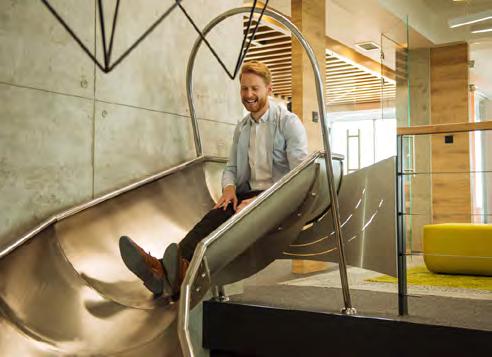
is suggesting trying to keep up with Google, but simple changes to the office environment can offer staff diverse spaces to work from and to enjoy, enhancing their work life experience, with overall happier staff leading to better productive outcomes.
Those that work in an office can spend upwards of seven hours per day sitting in the same spot. This means that they are doing a lot of
repetitive tasks and engaging in behaviours that may cause ergonomic injuries. When employees have more options in their workspace to encourage collaboration within their team, those choices are both mentally and physically stimulating and promote healthier wellbeing not just for the individual, but for the whole team.
Don’t be afraid to think outside the box when considering making changes for a better
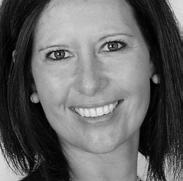
HUMAN RESOURCES
> BY KELLIE HAMLETT
Talent ID are Recruitment Specialists and can support you through your recruitment process. Please feel free to talk to us about this by calling 07 349 1081 or emailing kellie@talentid.co.nz
office health rating. Plants, artwork and even floor mats can be simple contributors that can add to the feel of the space. Obviously providing good furniture and ergonomic keyboards is a great idea, but also think about having some tables that provide a collaborative space rather than everybody just collaborating from their desks. Providing pictures of stretching exercises that can be done while standing at the photocopier for 30 seconds at a time all help contribute to healthier staff. Just moving from your desk to a different area can help. Promotion of employee’s health is essential to the success of a healthier office.
Natural light is essential to a healthy workspace too, but if natural light is limited, schedule regular intervals to go outside and get some fresh air. Get active at work and offer up spaces where you can have a stretch or take a break away from the desk or main office
space. If you’re lucky enough to have an outdoor area in your office then use this advantage too. It should be made to feel welcoming to encourage usage, not just to be classed as “the smokers’ corner”.
This can be a great collaboration space where meetings are taken outdoors away from desks and can allow employees to soak up some vitamin D while they are at it. In this day and age, being socially aware of our carbon footprint is also top of people’s minds. Working for a company that is conscious of its own carbon footprint is important to many. Simple changes here can help with the psychosocial factor of a healthy office, for example providing a space for bike parking can encourage employees to bike to work, reducing their CO2 and leaving them with more in their pockets (especially with the price of fuel and parking these days). Other environmental practices include minimizing
waste, switching to low carbon lighting, or the use of laptops over desk top computers (these are 80% more energy efficient). Taking a firm approach to sustainability aligns with employee’s values and offers great company morale, delivering healthy outcomes for people and the planet. Companies that promote a healthier workspace tend to have better retention of staff, as well as happier employees. Happier employees are the most productive. Healthy workspaces are ones where team members feel confident and comfortable with the work they are doing. Having fun at work as well as having a healthy workspace is essential to productivity. Having a healthy workspace is vital in this day and age. Overall, improving the office space to be a healthier environment is beneficial to not just the employees, but also the overall productivity, reputation and success of the business.
How ECI will benefit delivery of new homes and amenities at Metlifecare’s Somervale Village
As one of a few building companies in the Bay of Plenty and Waikato to offer a specialised Early Contractor Involvement (ECI) team, the Foster Group have been heavily involved in the design phase of Metlifecare’s regeneration project at Somervale Village at Mount Maunganui.
ECI is a pre-construction phase that reduces risk for the client, the construction team, and in this case, everyone living and working at Somervale Village.
Combining preconstruction management and Building Information Modelling (BIM), building services management, and quantity surveying – Fosters ECI team take care of budget management, early materials and trade procurement, and final design coordination.
For Metlifecare, ECI provides clarification around every step of the project; ensuring delivery is smooth, budget and timeframes are protected, and any risks are identified and mitigated. And, with the project targeting a Homestar 7 rating, Fosters’ knowledge and experience in delivering sustainable builds has also supported the inclusion of key sustainability features into this project design.
Fosters Preconstruction Manager Craig McCullough notes that the ECI phase is especially
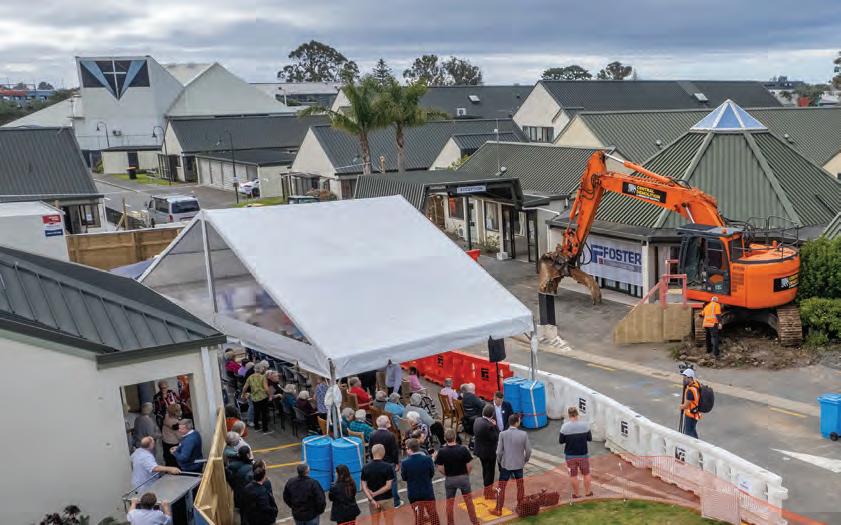
helpful in projects on an operational site, where the needs of different groups of stakeholders require careful consideration and coordination.
“In the case of Somervale, there are several intricacies with existing services as well as a need to work closely with village staff and, importantly, village residents” he explains. “Our chief concern is managing the project in a live environment with minimal disruption to the village.
“Through the ECI phase, we’ve planned site access, phasing, and construction methodology. Our work will ensure the successful integration of construction innovations and that the project meets Homestar targets.
“It has been a pleasure working with Metlifecare and their design consultants” Craig continues. “With everyone committing to the ECI process, we successfully established a budget early on and have designed to it. We now have a comprehensive programme of works in place, with thought and consideration given to safety, costefficiency, and the project timeline.”
Stage 1 of this project will deliver a modern amenity building and 30 new independent living apartments into the retirement village by mid2024.
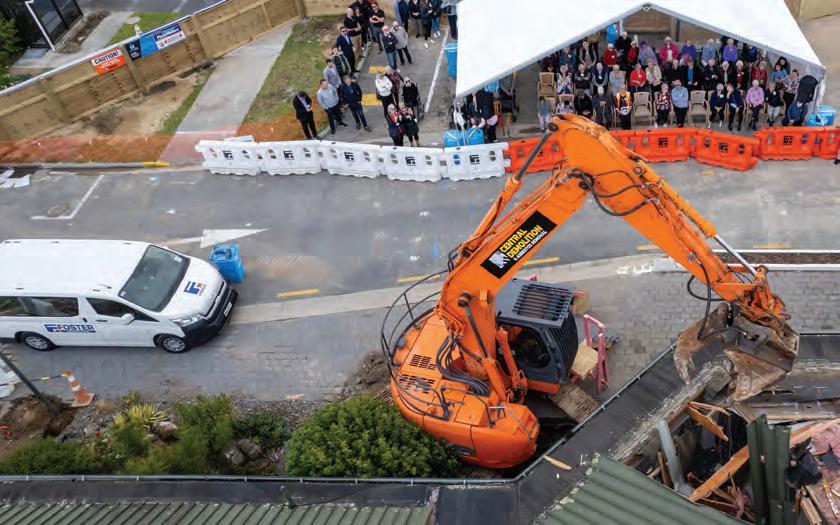
Demolition of the old Somervale care home marked the start of the Metlifecare regeneration project in August.
